Figures of the month 2025

Edward Morgan and Jenny Jones
This is a rare pair of figures portraying Edward Morgan and Jenny Jones, titled with gilt script. The romantic tale of Morgan and Jones was set to music in 1825 by Charles James Mathews.
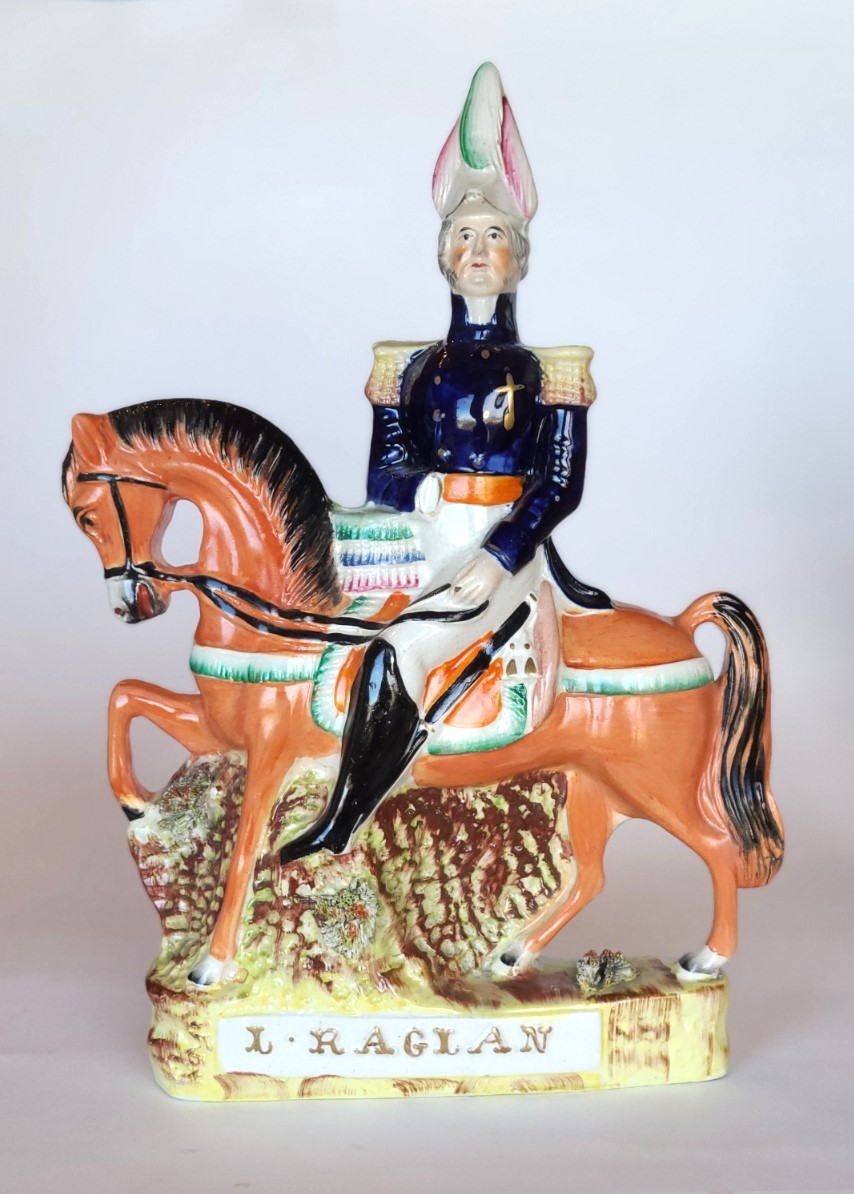
Field Marshal Fitzroy Raglan
This is a rare figure of Field Marshal Fitzroy Raglan. The figure stands about 12 1/4” tall and dates to about 1854.
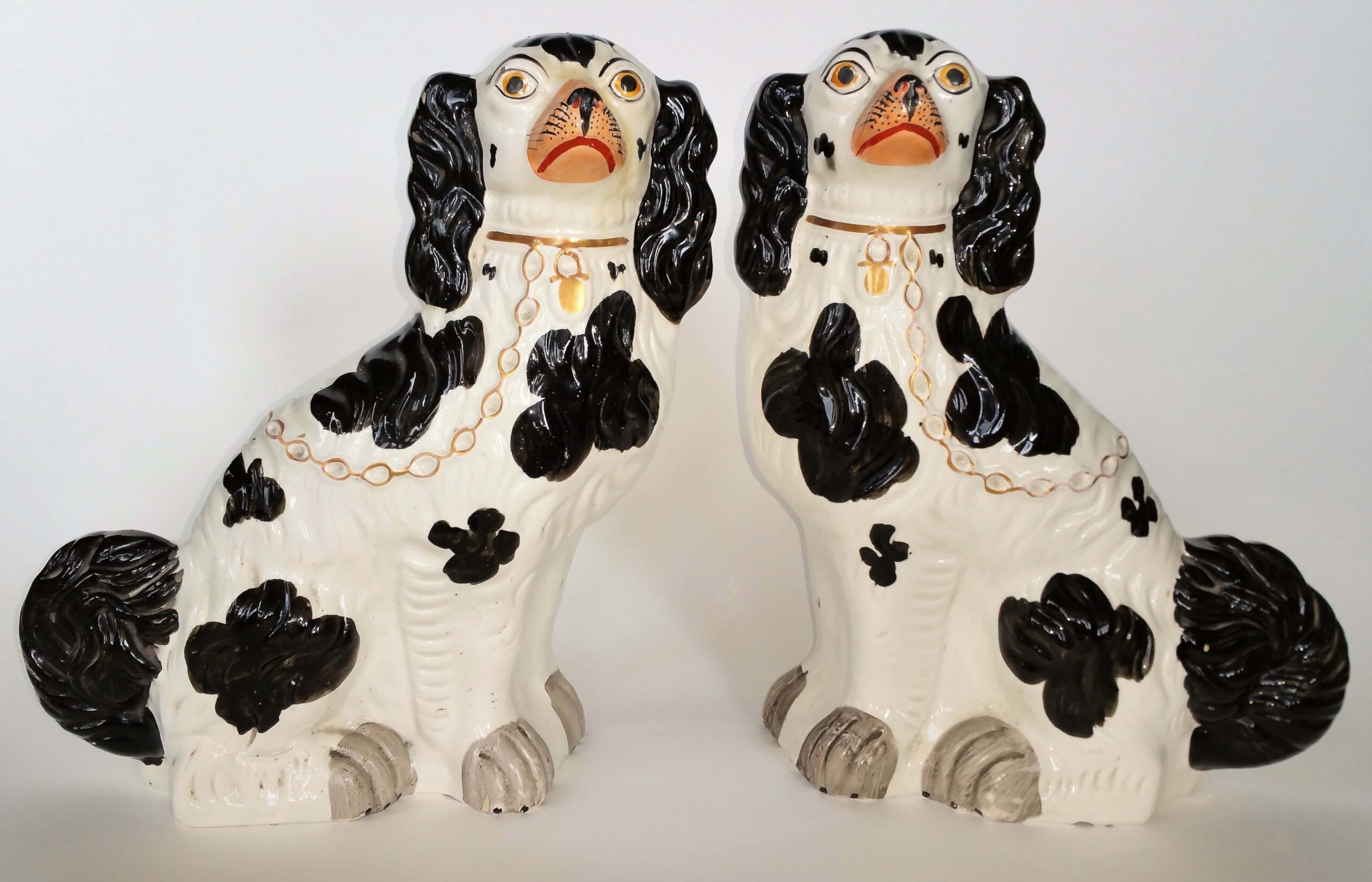
Black and white spaniels
This is fine pair of #1 black and white Staffordshire spaniels. They have a raised number one on the underside, designating them as the largest in a series of six sizes, number six being the smallest.
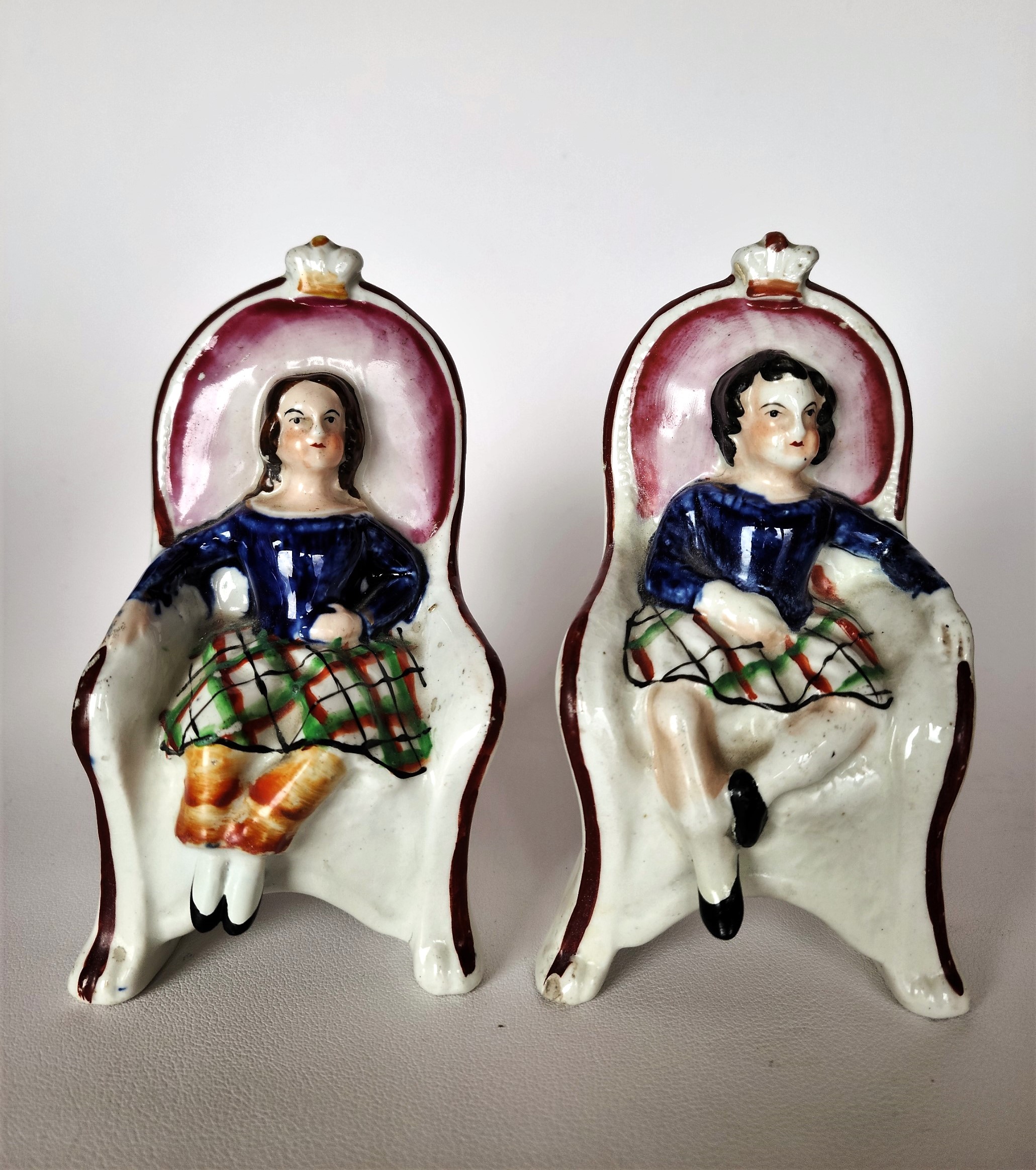
Royal children seated
This is a very rare pair of Staffordshire figures representing the Princess Royal and the Prince of Wales, seated in chairs. Each figure is approximately 5” tall and dates to about 1845.
Figures of the month 2024
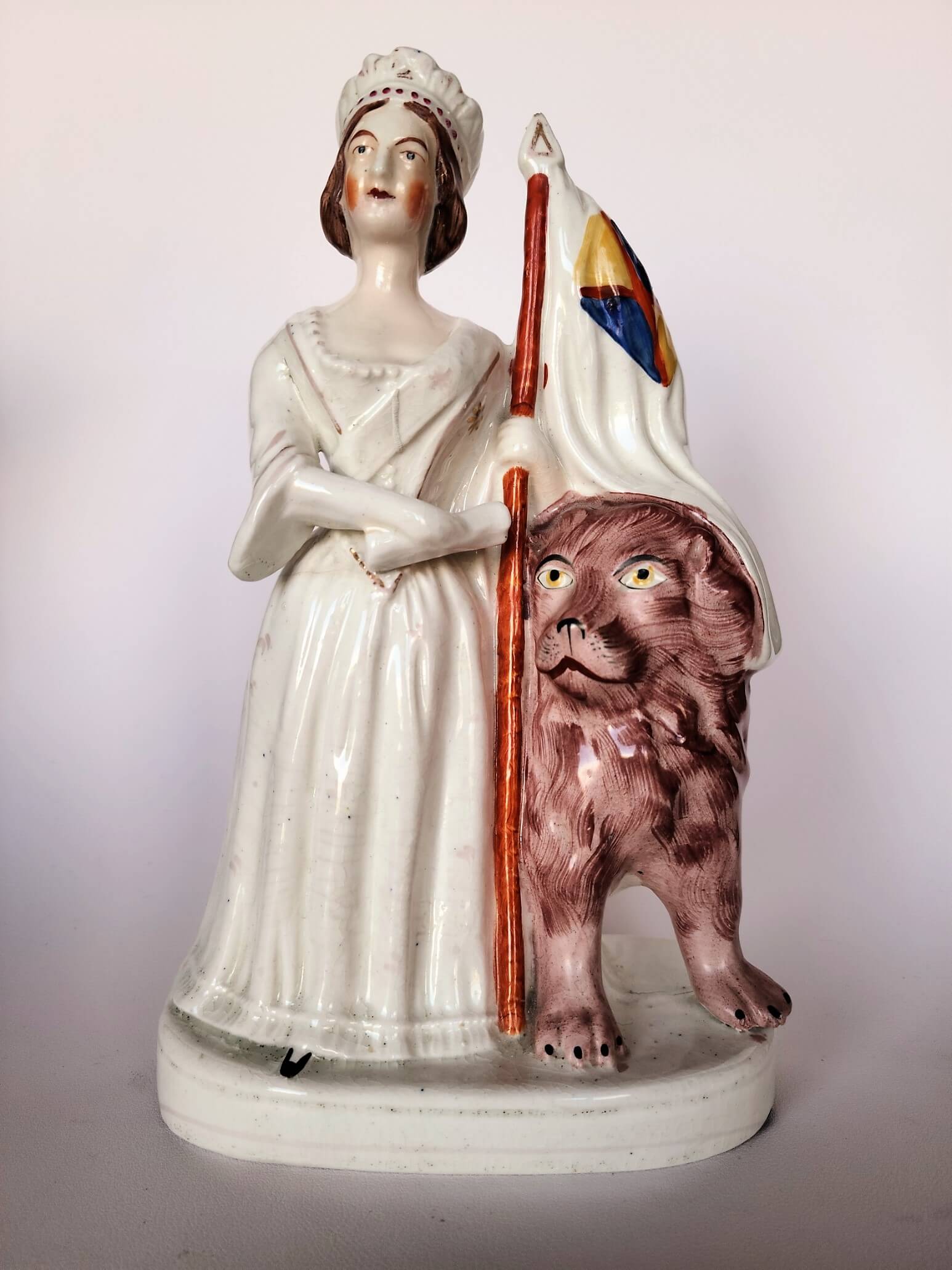
Queen Victoria
This is a rare Staffordshire figure of Queen Victoria, standing 8 3/4” tall and dating to approximately 1855. The Queen stands holding the staff of a flag in her left hand and a scroll in her right hand.

Victor Emmanuel II
This is a rare Staffordshire military figure of Victor Emmanuel II, standing 17” tall, dating to approximately 1855. It is titled in gold, raised capital letters, “KING OF SARDINIA”.

Dr Dulcamara and Adina
This is a rare pair of Staffordshire theatrical figures, standing 8 ½” tall and dating to approximately 1848. The male character represents Dr Dulcamara, as portrayed by Luigi Lablache, in Donizetti’s comedic melodrama L’elisir d’amore (The Elixir of Love). The female actress, playing the role of Adina, is unidentified.

John Liston
This is an early Staffordshire figure of the actor John Liston, portraying the role of Van Dunder in the play ‘Twould Puzzle a Conjuror’ or ‘The Two Peters’, by John Poole.
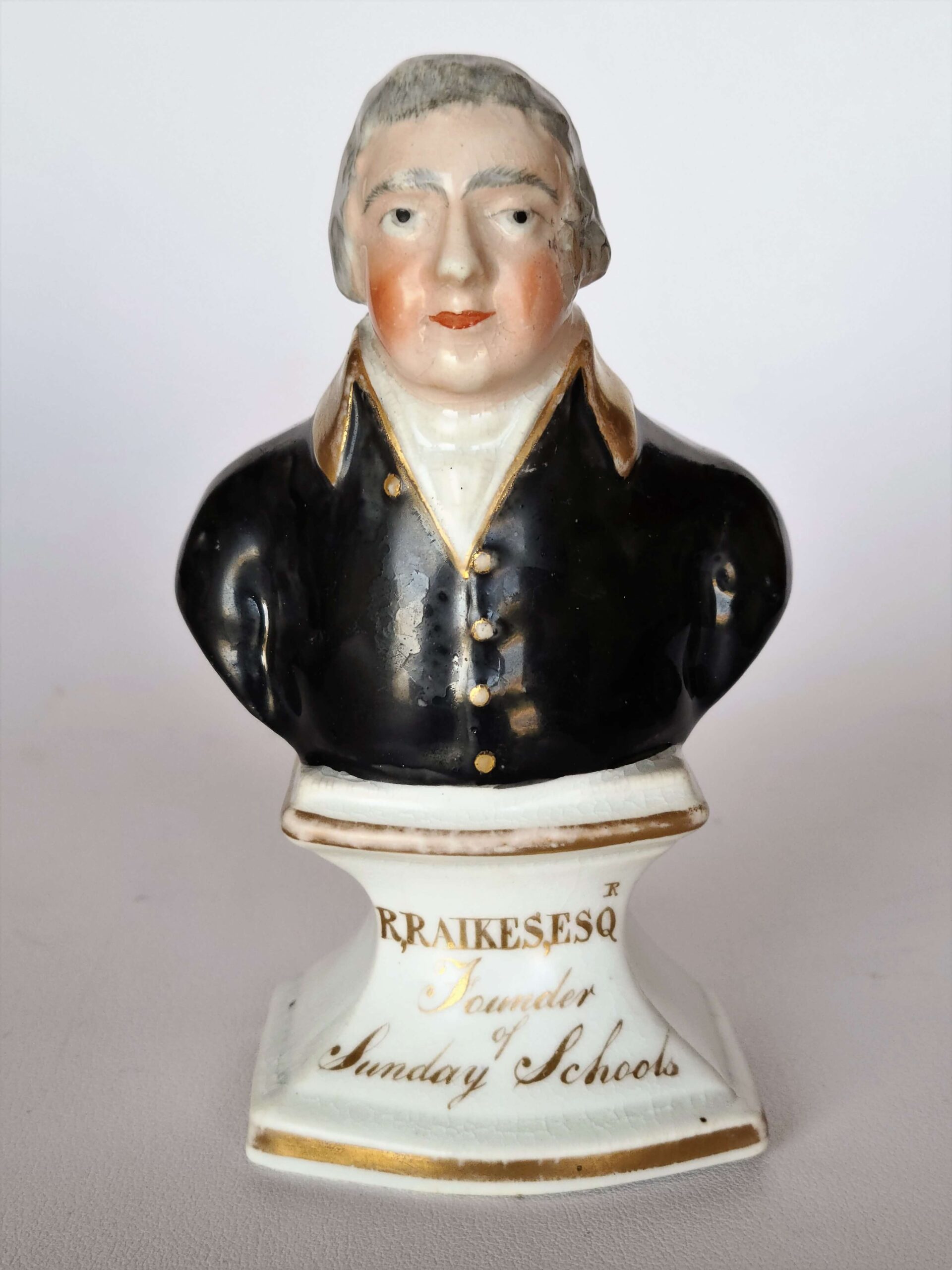
Robert Raikes
This is a very rare Staffordshire bust of Robert Raikes, an Anglican layman and English philanthropist. The figure is titled in gilt script as “Founder of the Sunday School”, but it would be more accurate to say he was a pioneer, or promoter, of Sunday Schools.

Elizabeth Barrett Browning
This is a rare Staffordshire figure of a woman seated on a couch, with her dog beside her. It is generally believed to represent Elizabeth Barrett Browning, and her dog Flush. This figure stands about 5 ¼” tall and dates to approximately 1846-1850.

A pair of camels
This is an interesting pair of Staffordshire camels, each about 6 1/4” tall, and dating to approximately 1860.

Prophet Elijah and the Widow of Zarephath
This is a fine pair of early Staffordshire figures of Elijah, the Old Testament prophet, and the Widow of Zarephath. This pair of figures is attributed to Obadiah Sherratt, the table bases, bocage, and flowers being typical of Sherratt.

Boys playing cricket
This is a pair of Staffordshire figures of unidentified boys playing cricket, standing 6 ½” and 6 ¾” tall, dating to around 1850.

Tom King and Dick Turpin
This is a fine pair of Staffordshire figures of Tom King and Dick Turpin, probably originating from a theatrical production. Note the four separately moulded legs on each horse.

Artabanes
This is a theatrical figure representing an actor in the role of Artabanes, from the opera Artaxerxes. The figure stands 11 3/4” tall, dates to approximately 1830-1840, and is very rare. There is a dagger in his right hand, part of the blade being hidden beneath his sash. The interior and the edging of his coat are fully lined with ermine.
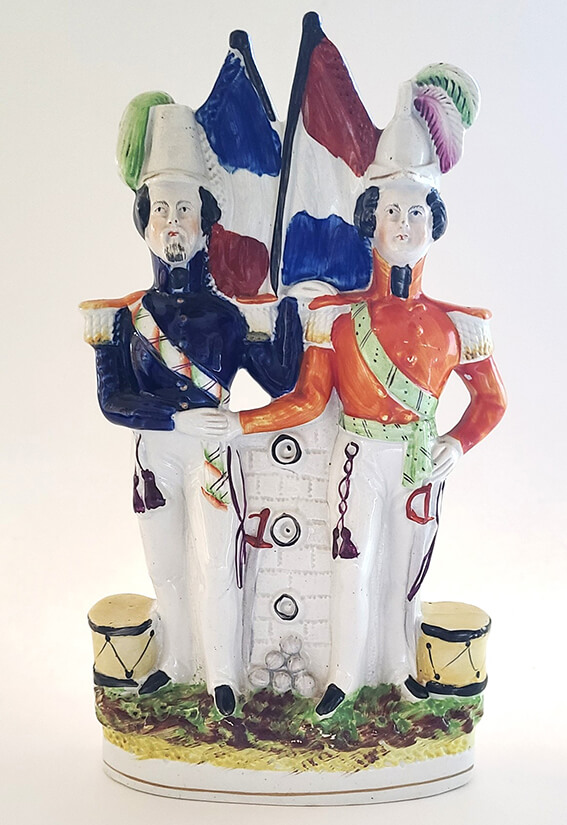
Napoleon III with Prince Albert
This is a figure of Napoleon III with Prince Albert, each with a drum on the ground and to the side. The figure stands 10 ¾” and dates to about 1854.
Figures of the month 2023

A pair of clowns
This is a fine pair of Staffordshire clowns, both standing 6 ½” tall, dating to circa 1860. Each is wearing pantaloons, with the figure on the left holding a cane.
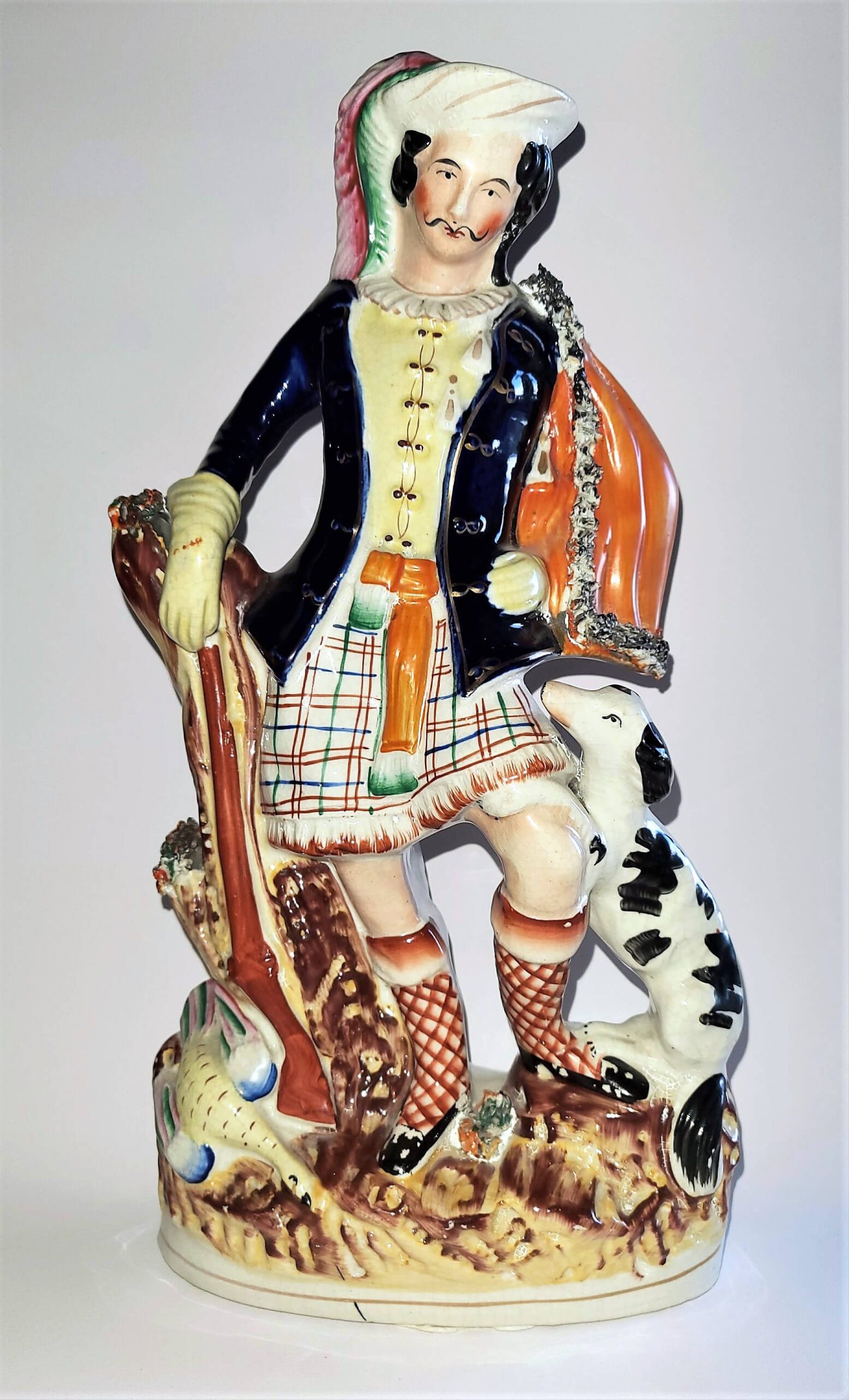
Scottish hunter
This is an interesting example of a Scottish hunter, wearing kilt and underglaze blue coat, with a dog at his knee and a rifle resting near his right hand. The figure stands 14 ¼” tall and dates to about 1860.

A pair of Bullmastiffs
This is a pair of recumbent Bullmastiff dogs, approximately 6” tall, dating to around 1850-1860. This English breed was developed as a guard dog in the nineteenth century and is also known as the Gamekeeper’s Night Dog.

Prince of Wales
This is a rare figure of Prince Albert Edward, the Prince of Wales, second child and eldest son of Queen Victoria and Prince Albert. He stands with his right hand resting on the head of a brown and white dog, and his left hand on the barrel of a rifle.
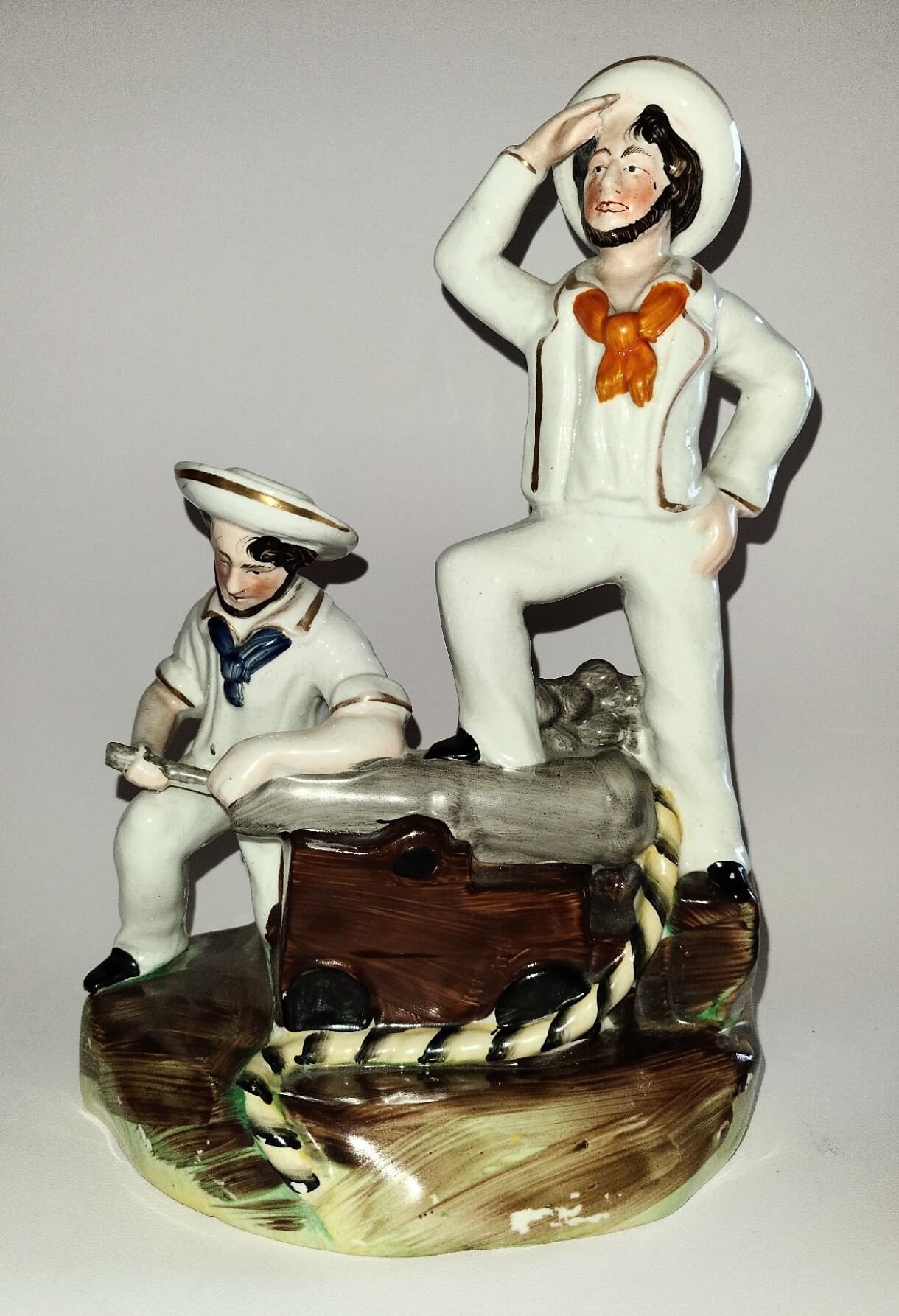
Sailors with cannon
This is a rare Crimean War figure representing two naval gunners with a cannon. One sailor stands upright with his right foot on the cannon, and his right hand to his head as if saluting. The second sailor is kneeling while priming the cannon.
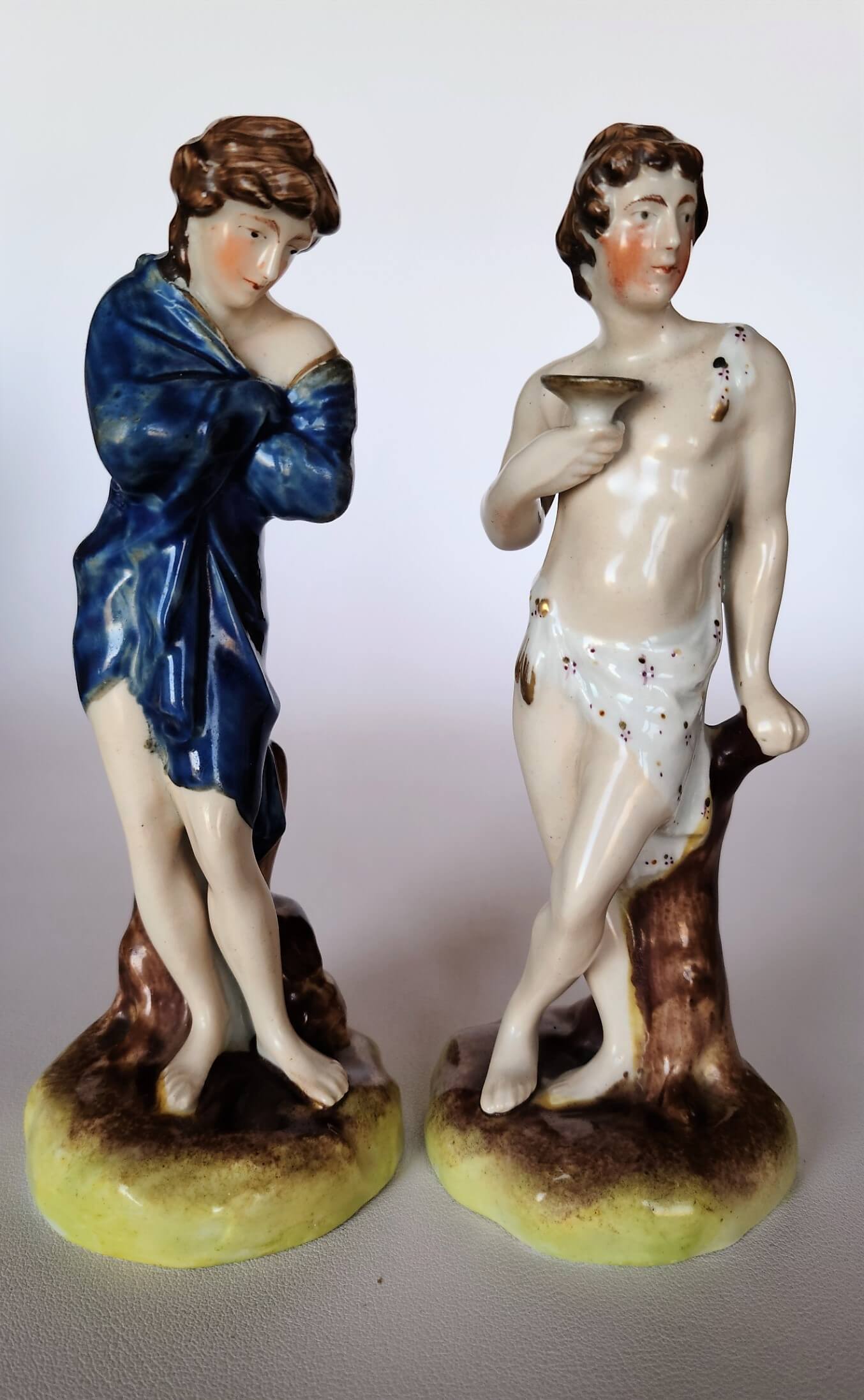
Winter and Summer
This is a rare pair of Staffordshire figures representing two of the four seasons, Winter and Summer. Each figure stands a little over 6 ½” tall and dates to around 1850 – 1860.
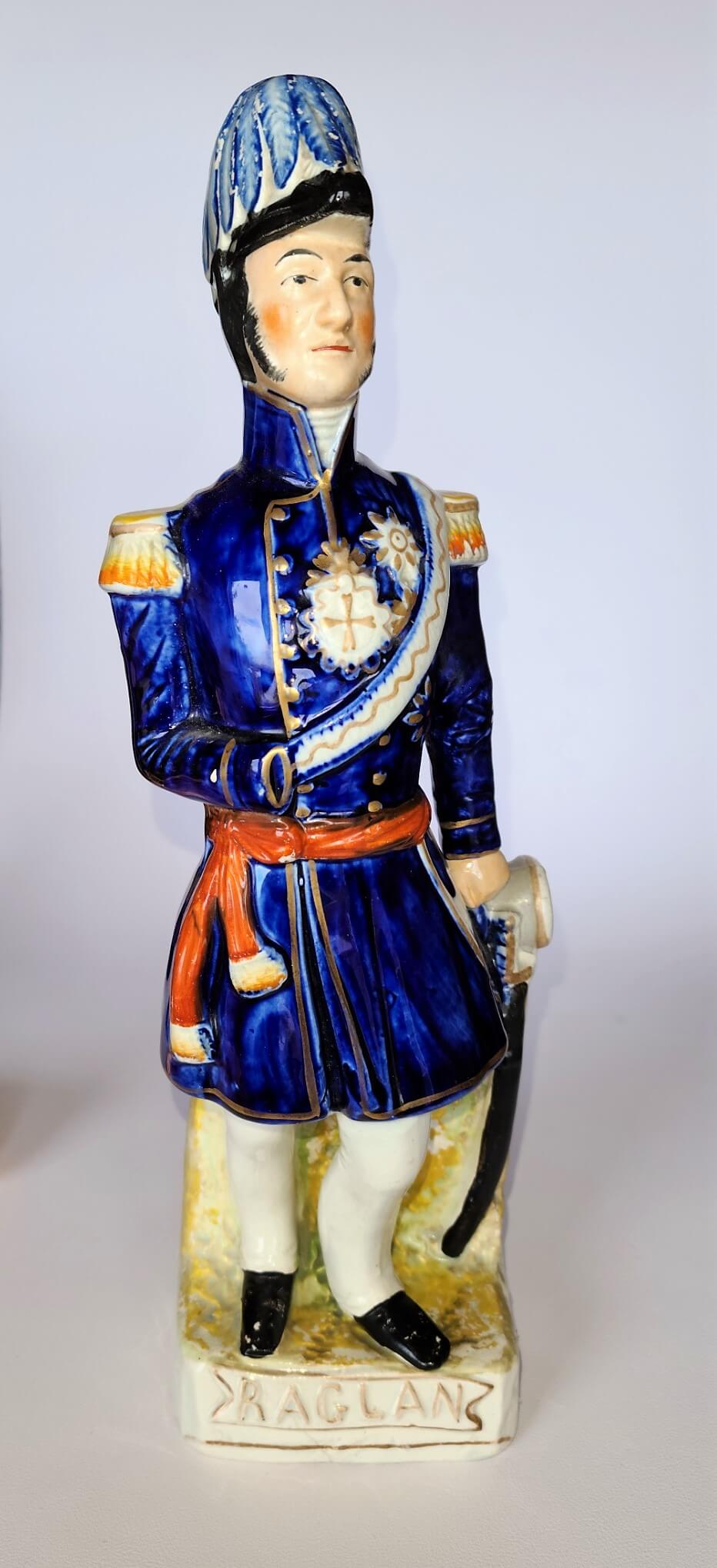
Lord Raglan
This is a very rare and desirable titled Staffordshire figure of FitzRoy James Henry Somerset Raglan, aka Field Marshal Lord Raglan. The figure stands a little over 13” tall and dates to around 1854.

Pair of white cats
This is a rare pair of seated cats, approximately 13 ½” tall. They are decorated in bright gold and date to around 1870-1880. Harding Book Two illustrates this impressive pair on page 239.
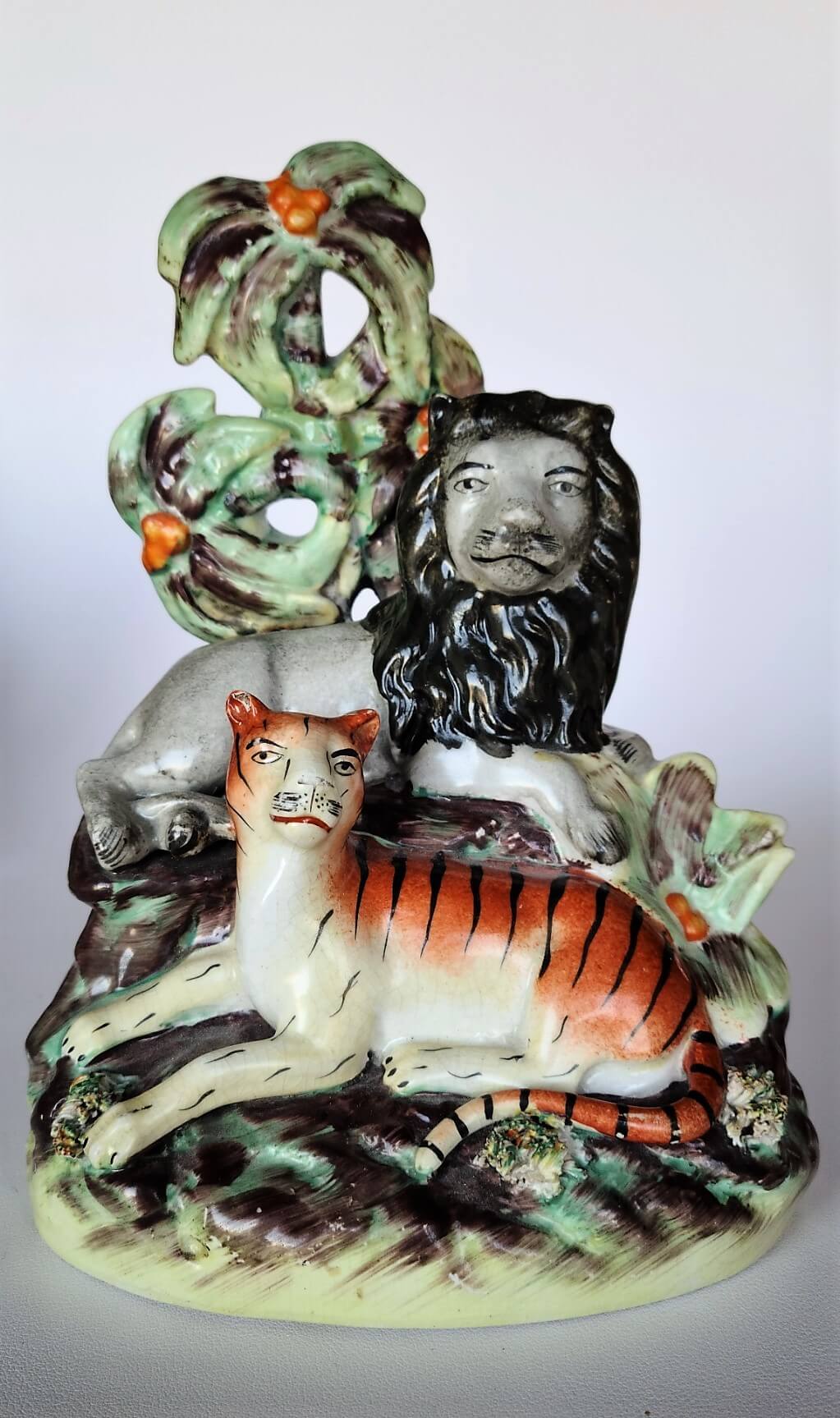
Tiger and lion
This is a rare figure of a tiger and lion lying in front of a palm tree. Circus acts with wild animals became very popular in England during the 1830s and it is possible that this figure as well as other animal figures commemorated these events.

Lady Godiva
This is a rare figure portraying Lady Godiva seated sidesaddle on horseback. The figure is titled “Lady Godiva” and is decorated in the manner of the Parr factory, with soft yellow, green, and brown brushstrokes.

Lost Piece
This is an early Staffordshire figure of a woman standing on a grassy pedestal, with a coin in her extended hand. The figure is titled “Lost Piece” and represents the biblical verses found in Luke 15:8-10.

William Shakespeare
This is a gilt script titled figure of William Shakespeare with his right arm resting on a book atop a pedestal. Next to the pedestal is a sloped watch holder with a clock face painted inside, sitting atop a tree decorated with grapes.
Figures of the month 2022

Children on Saint Bernard dogs
This is a very rare pair of children seated sideways on Saint Bernards. More common figures have the children laying down or seated facing forward. Others have the rear arms moulded into the figures, instead of being separately moulded as these are. These figures are approximately 10” tall and date to around 1840-1850.
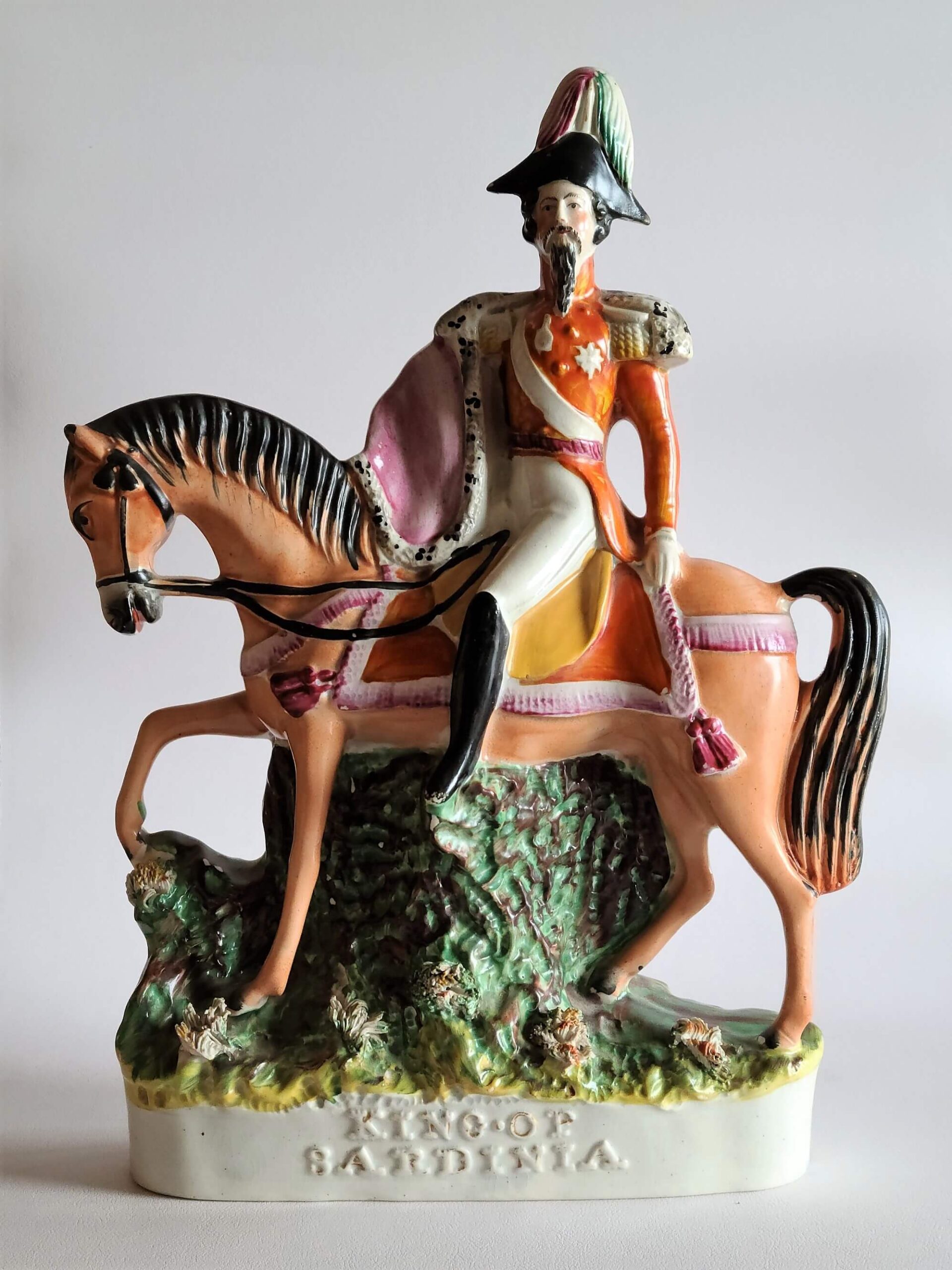
King of Sardinia
This is a rare figure of Victor Emmanuel II, the King of Sardinia and later the first King of Italy. The figure is titled with gold accented raised capitals, stands approximately 12 3/4” tall, and dates to about 1855. It is probably a Crimean war figure, with Emmanuel being shown in military uniform.
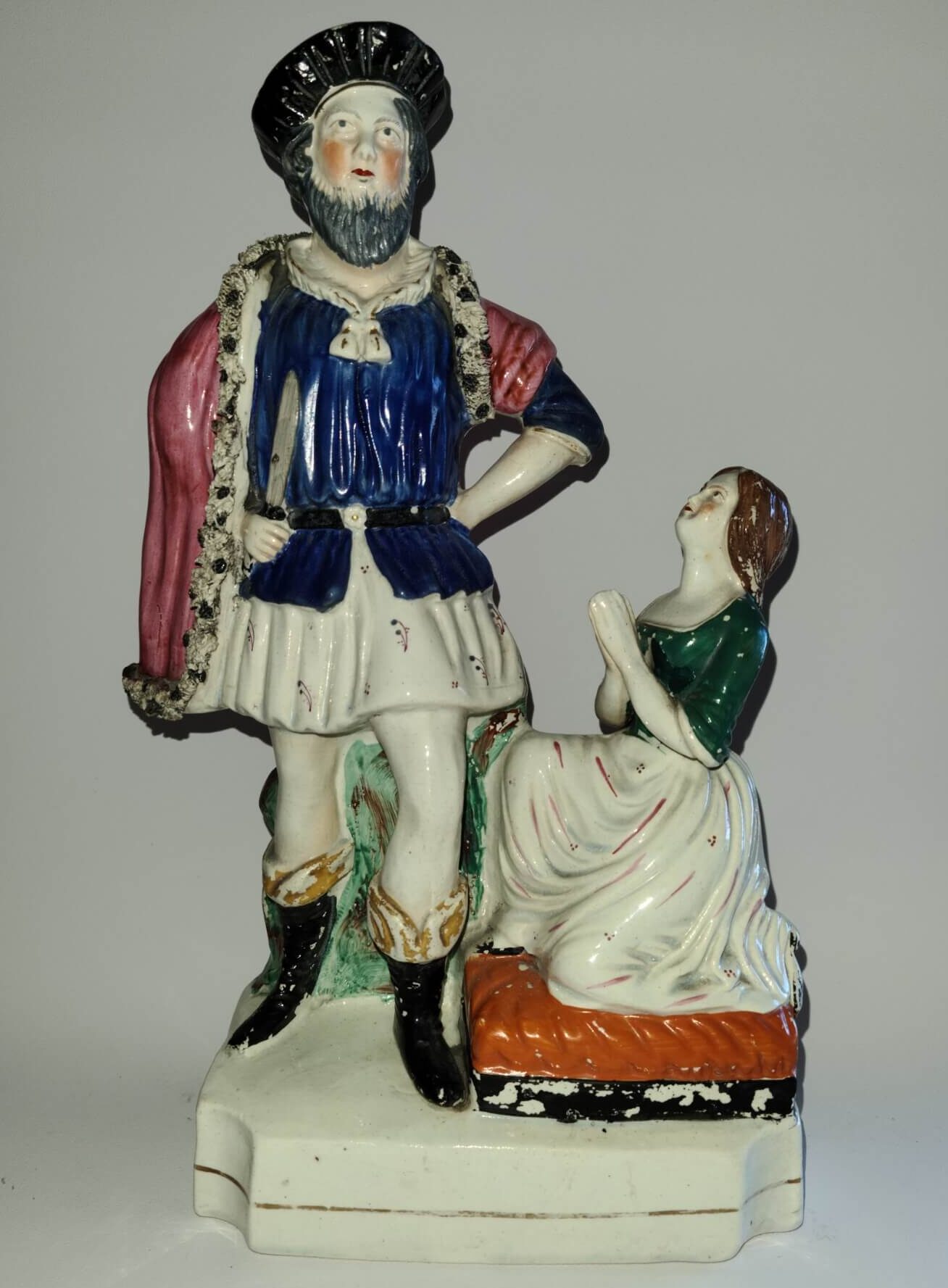
Bluebeard and Fatima
This is a rare figure of Bluebeard and Fatima, approximately 12 1/2” tall, dating to 1858. Bluebeard is easily recognized with his blue beard. He stands upright with a knife in his right hand and left hand on his hip. Fatima is kneeling before Bluebeard with eyes cast upward toward him, hands folded in a prayer-like position.

Napoleon Bonaparte
This is a very rare figure of Napoleon Bonaparte, approximately 8 ¼” tall, dating to about 1840. He stands with arms crossed next to a pedestal with a cloak draped over it. The base is decorated with an interesting marble effect, and it bears the title “N”.

Fox and monkey
What an interesting figure of a fox and monkey, 4 3/4” tall. The figure is rare and probably represents one of Aesop’s Fables called “The Fox and the Monkey”.
It is circa 1840, partially painted in the round, and has a solid base.

Unidentified man and woman
This is an interesting figure of a man and a woman, 7 ½” tall. It would be unremarkable if not for the head peering out from behind the man’s left leg.
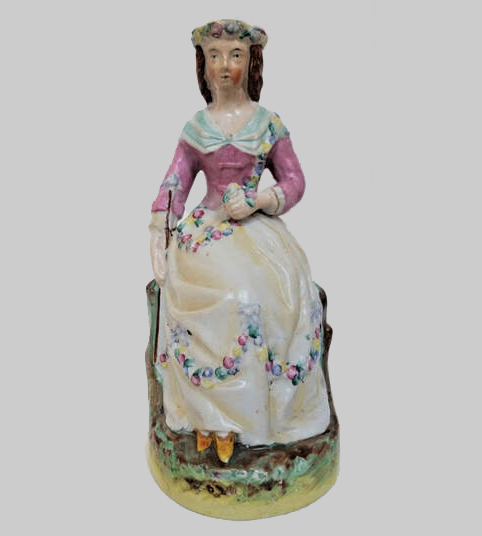
Titania
This is a very rare figure of a woman in full length dress and a floral headband, standing 8 ½” tall. She holds a wand in her right hand and a posy in her left.

Sebastopol
It is perhaps appropriate to show this figure as the Figure of the Month for May 2022, as we stand in solidarity with the Ukranian people under siege by the Russians.
Sebastopol was a Russian fortress that played an important part in the Crimean war. This figure was made at the time of the war, circa 1854.
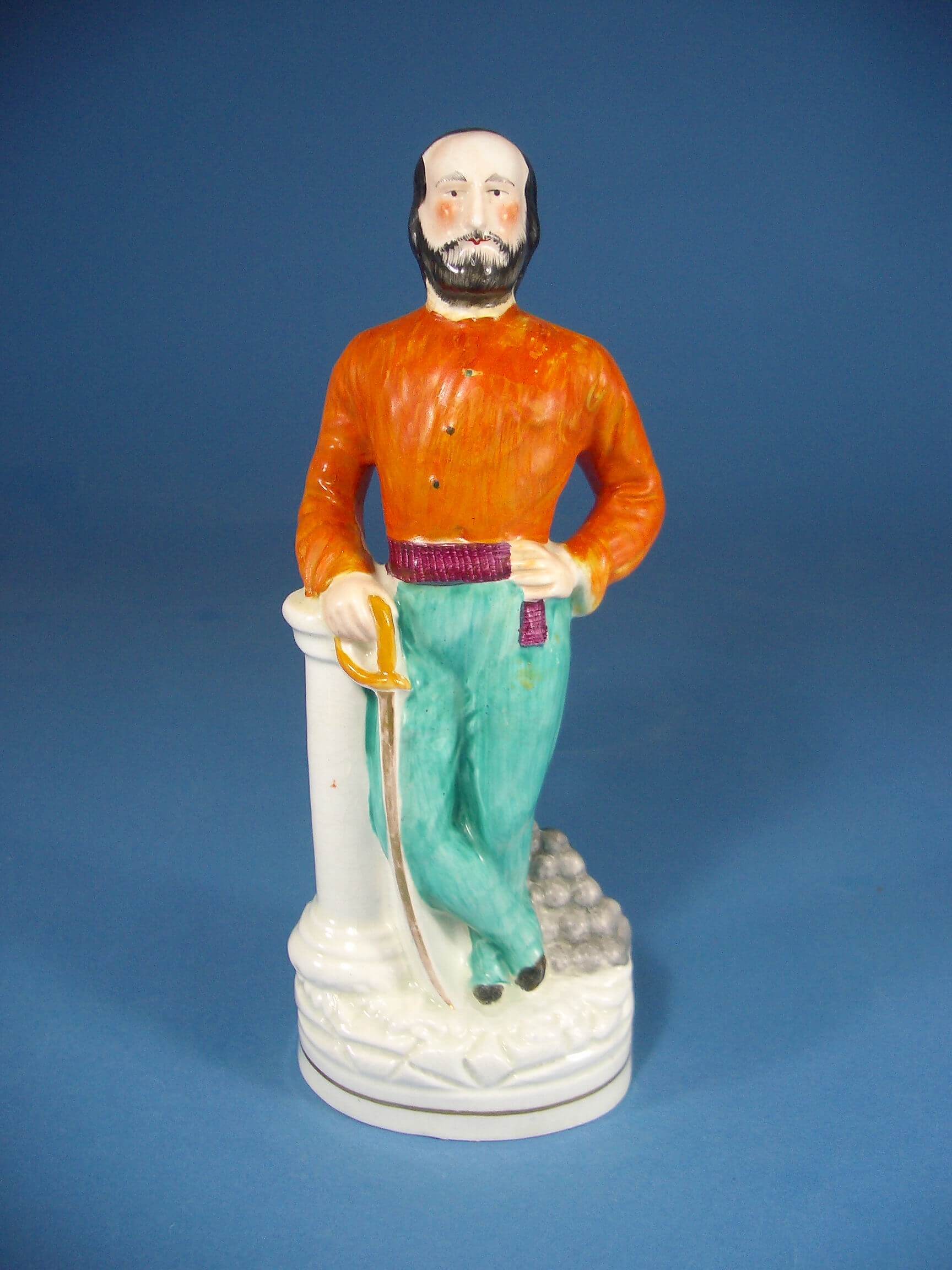
Garibaldi
Giuseppe Garibaldi was an Italian soldier and patriot who helped unify Italy. In 1864, he visited England and was welcomed with great enthusiasm. Garibaldi and his “red shirts” were heroes in the story of Italian independence.

Giaffier and Zuleika
This figure portrays a highlight in Act I Scene 3 of William Dimond’s dramatised version of Byron’s poem “The Bride of Abydos”. Mr Barton and Miss Rosa Henry are the actors, and the production was probably that at Astley’s Ampitheatre in London, in April 1847.
The figure is circa 1847 and 12.75 inches high and can be found in Pugh, page E379, figure 60.
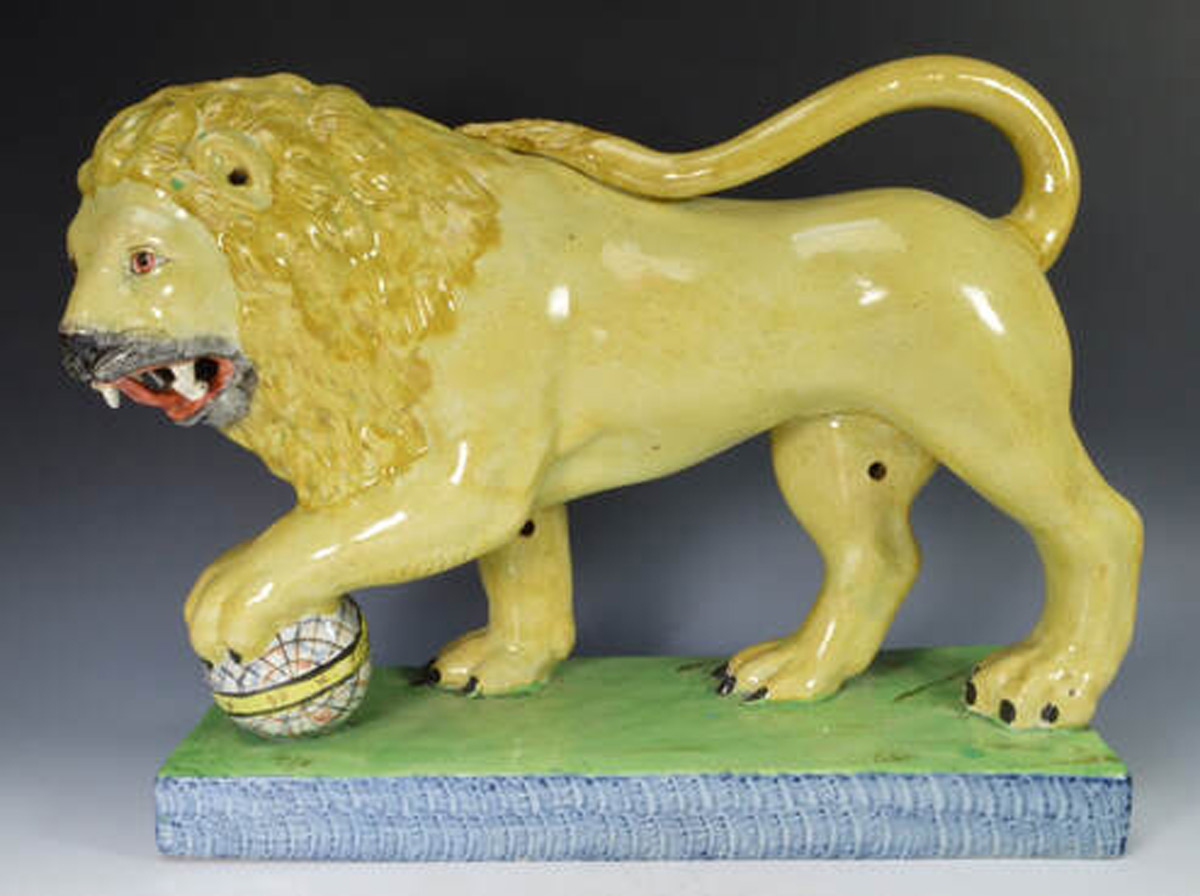
Lion
Lions have always been a popular subject for the Staffordshire potter. The quality of this beast is superb and in the Medici style. Circa 1820, it is 11.75 inches long, 9 inches high and is wonderfully decorated. I particularly like the base, the detail of the lion’s face, and the fact that the lion has […]

Sir George Brown and Sir James Simpson
This pair of military figures features two generals each holding a flag, seated on horseback. They are titled G BROWN (l) and GNL SIMPSON (r).
Figures of the month 2021

Christmas Evans
Reverend Christmas Evans was a Welsh preacher who began life as a farm labourer. In 1788, he sustained an injury to his right eye in a religious brawl.

A pair of swans
The Staffordshire potters made May crock (egg) baskets. These were usually of hens but there are examples of other birds such as ducks, guinea fowl, pigeons, etc. These are rare examples of swans which are beautifully modelled and decorated with gilt on white. They are 8 inches high and unrecorded.

Othello and Iago
This figure circa 1858, is based on a watercolor “Othello and Iago” by S A Hart exhibited in the Royal Academy in 1858. An engraving of the painting was also published in the National Magazine in 1858. It is 12 inches high and can be found in Pugh pages E370-E371, plate 13, figure 31.

Early Bull
A rare pottery figure circa 1800-1820 of a bull decorated with a most unusual and unique stripe effect, almost representing a tiger.

Queen Victoria and Prince of Wales
A pair of very imposing figures made by the Sampson Smith factory circa 1870. They are 17.5 inches and 18 inches tall respectively. See Pugh pages A164-165, plate 81, figs 235 and 236.

Coursing greyhounds
Coursing, the pursuit of hares by greyhounds, was a very popular Victorian sport. The whippet is a smaller dog but very similar in type to a greyhound and would have been kept by many country folks.

Begging Spaniel Dogs
These are charming pottery pearlware figures circa 1820 of begging spaniel dogs.

Death of Nelson
Nelson was shot through the eye by a rogue French rifleman at the Battle of Trafalgar in 1805. He lies dying in the arms of two of his crew.

Urania
Urania was the Greek goddess of truth, is also the muse of astronomy and is usually portrayed holding a globe or compass.
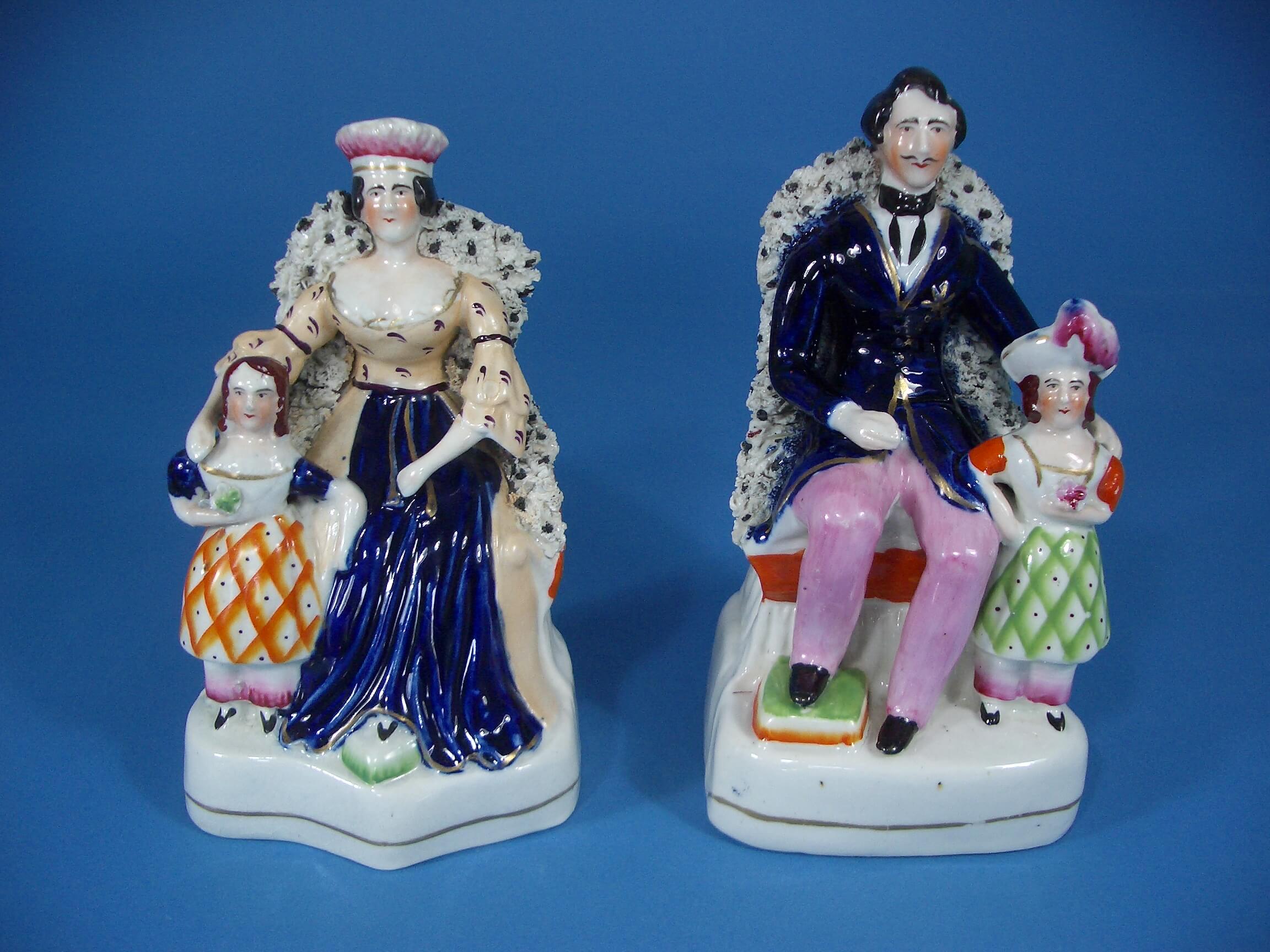
Victoria and Albert with Royal children
Queen Victoria with the Princess Royal pairs with Prince Albert and their son Albery Edward.

Charity
Charity is believed to be the greatest of the virtues, embodying both the love of God and others.
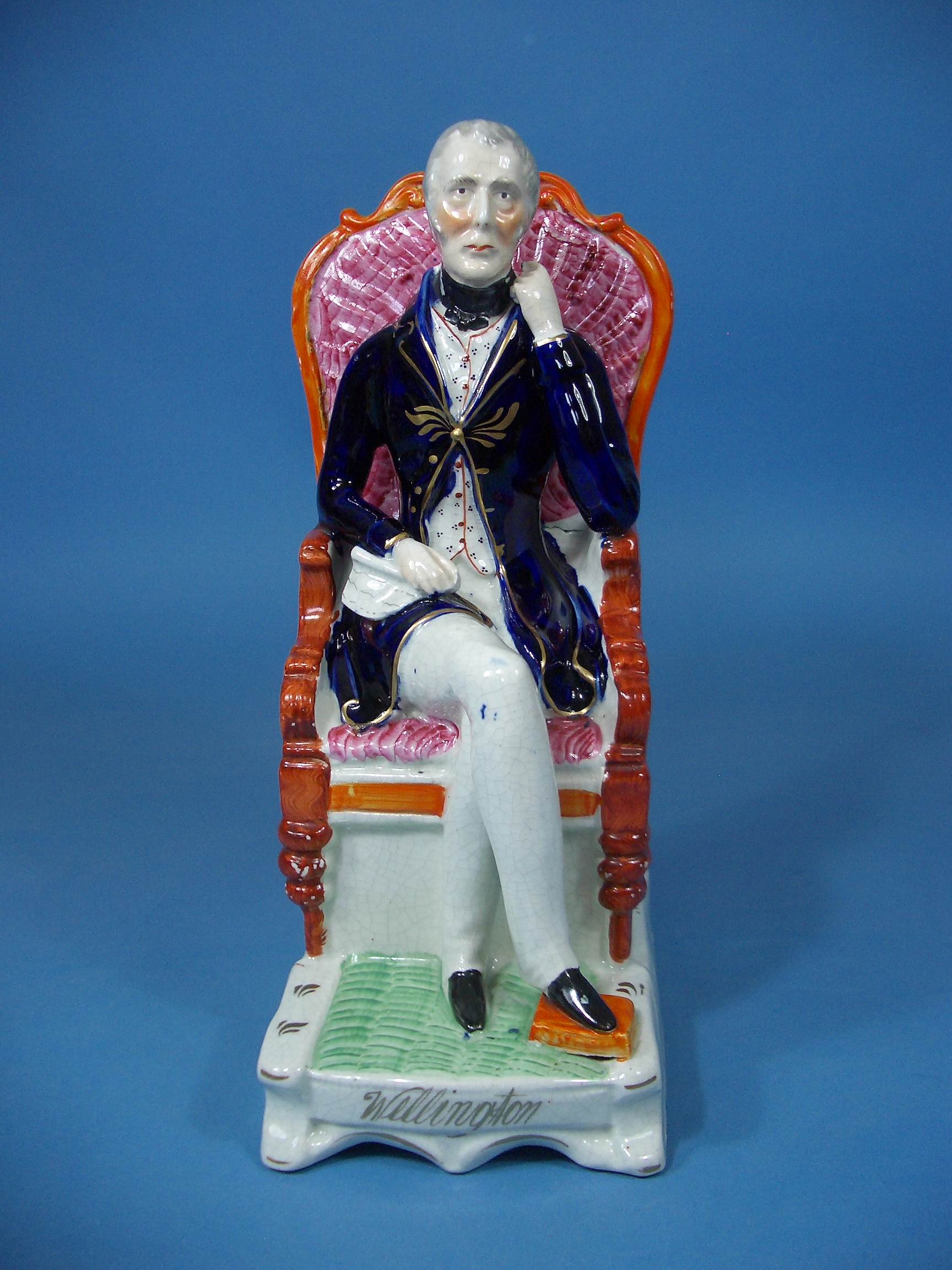
Duke of Wellington
Wellington was the most famous British General of the 19th century and his funeral at St. Paul’s Cathedral was one of the great pageants of history.
Figures of the month 2020

Venus and Neptune
Venus the Roman Goddess of Love and mother of Cupid, and Neptune the God of the Seas, are both well represented in ancient statuary and Old Master works of art.

Tiger Hunter
Queen Victoria was also titled The Empress of India. India was a colony of Great Britain and hugely important for the trade that existed between those two countries.

Bust of Napoleon Bonaparte
Bonaparte (1769-1821) rose from humble beginnings to become one of the greatest military commanders of all time and the first Emperor of France.
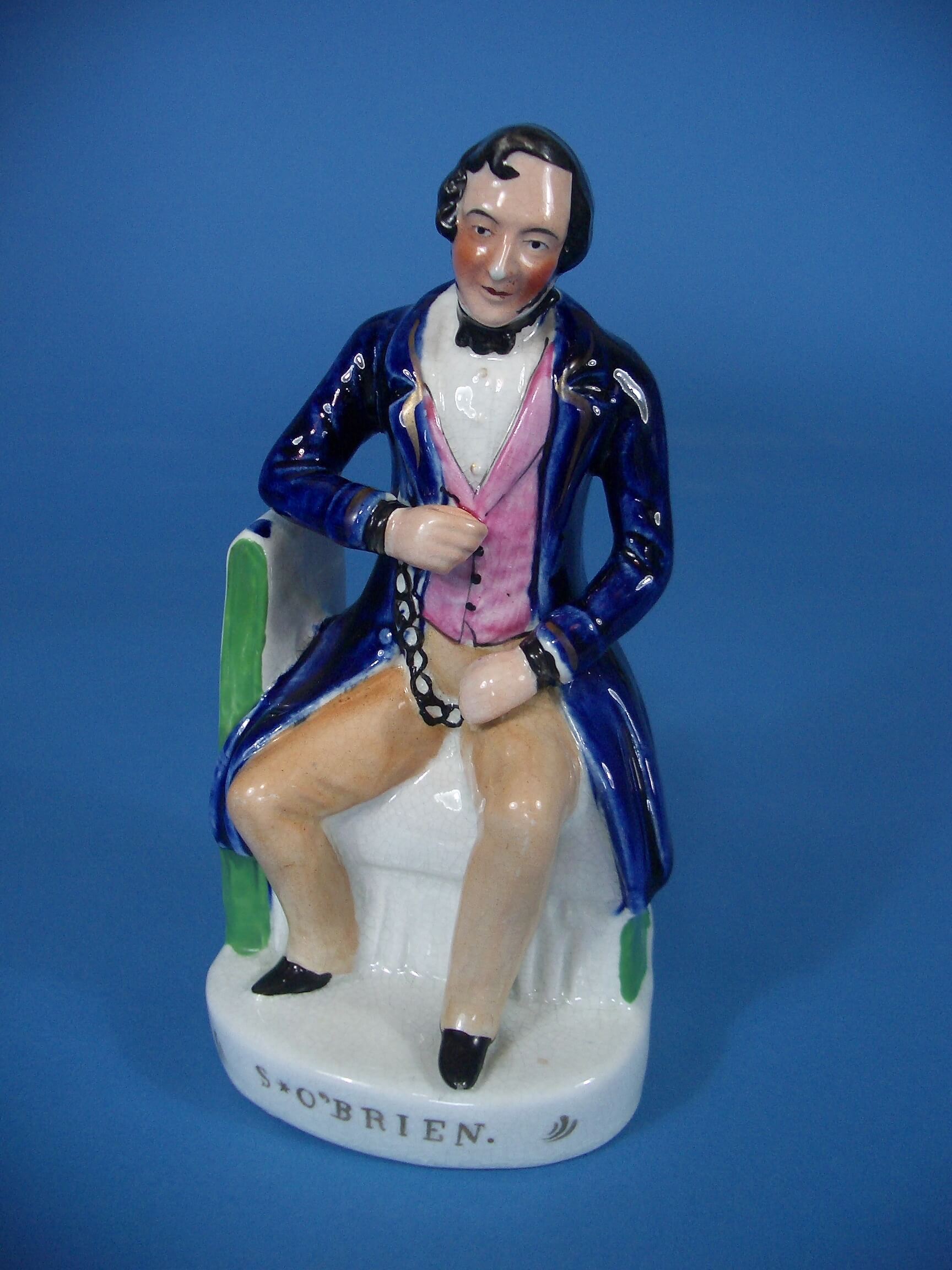
William Smith O’Brien
O’Brien (1803-1864) was an Irish nationalist. He entered parliament in 1826 and made repeated efforts to improve poor relief and education in Ireland.

Reading Maid
In the early 1800s, feeble improvements in England’s ramshackle educational system coupled with an ever-growing supply of affordable reading matter resulted in the explosive growth of the reading public.

Pair of hunting dogs
Country pursuits were a big part of Victorian life both for the country squire and those who simply lived in the countryside and worked on the land.
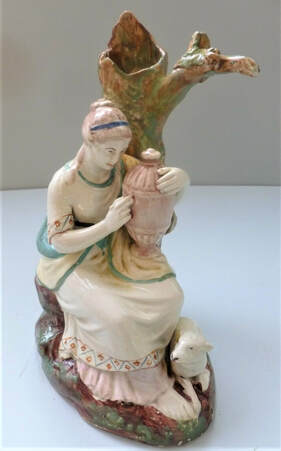
Agrippina
In the year 19 AD, the Roman commander Germanicus died of poisoning, and his widow Agrippina brought his ashes home. This tragic subject was appealing in the neoclassical period.

Ibrahim Pasha
Ibrahim Pasha (1789 – 1848) was the eldest son of Mohammed Ali the Viceroy of Egypt and Sudan. He served as a general in the Egyptian army that his father established during his reign, taking his first command of Egyptian forces when he was merely a teenager.
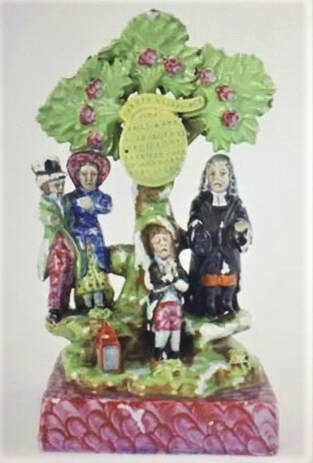
The New Marriage Act group
The bride and groom stand before a parson, whilst a young clerk beseeches the heavens for approval of the union, to commemorate the passage of The New Marriage Act of 1823, legislation that reinforced marriage.

The Legend of the Parson and his Clerk (circa 1820-30)
Many versions of this story exist but the most commonly told tale is that the Bishop of Exeter fell ill and came to Dawlish in the county of Devon to restore his health. However, an ambitious local parson aimed to succeed to the See (the bishop’s office) in the event of his superior’s demise.

John Carmel Heenan and Tom Sayers
Heenan was born in New York and Sayers was born in Pimlico London. Both were accomplished knuckle fighters. They fought on 17th April 1860 at Farnborough, attended by over 12000 people.
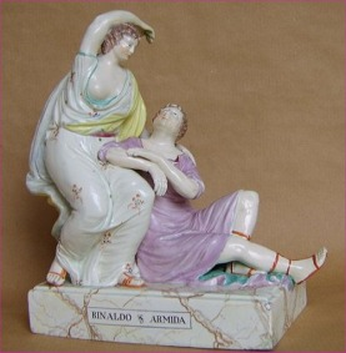
Rinaldo and Armida
The characters of Rinaldo and Armida are from Torquato Tasso’s poem “La Gerusalemme Liberata” (Jerusalem Delivered) circa 1581.
Figures of the month 2019
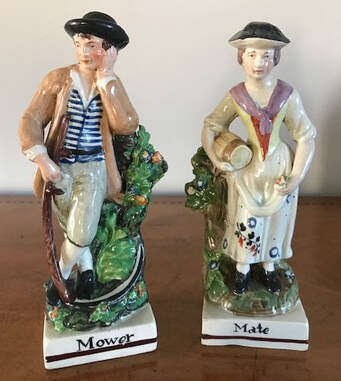
Dudson Mower and Mate figure
Dudson used several distinctive bocage forms that are very useful in identifying their figures, but these figures lack typical bocages. Instead, look at the x-shaped sprig on the Mate base. That x-sprig is specific to Dudson. When such a sprig is used it is akin to a Dudson signature. The Mower base also has x-sprigs on it but they are partial; they most likely broke as they were formed. Pictured below is an enlarged view of the x-sprig… it really is quite distinctive.
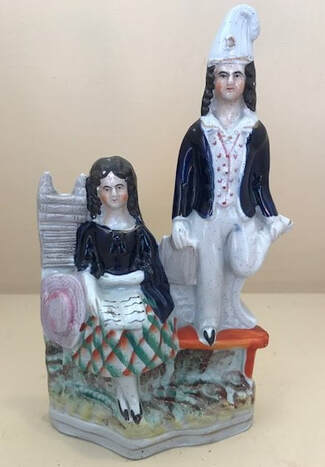
The good student and the dunce
Alan Sturrock says he has always liked Staffordshire figures which show the simple life so many of the Victorians had, and how very different life at all stages was as compared to today. This figure shows just that. The good student holding a book sits on a chair whilst the dunce stands next to her […]
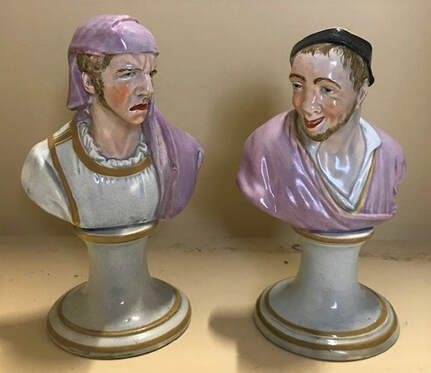
Heraclitus and Democritus
These are two companion classical busts sometimes referred to as Tragedy and Comedy. The sad faced figure on the left is Heraclitus (540-475 BC). He is known as The Weeping Philosopher because he found man’s condition melancholy. This Staffordshire example is circa 1780, stands 5.5 inches tall and is after a similar bust made by Derby. The […]
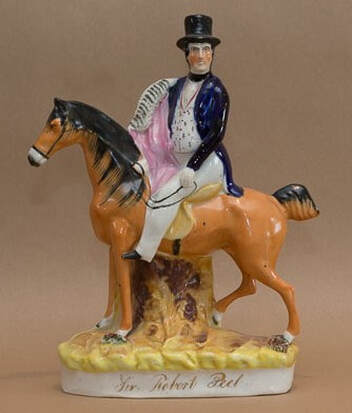
Sir Robert Peel
Peel was a British Conservative statesman who served twice as Prime Minister of the United Kingdom (1834-35 and 1841-46) and twice as Home Secretary (1822-27 and 1828-30). He founded the Metropolitan Police Service and was one of the founders of the modern Conservative (Tory) Party. The son of a wealthy textile manufacturer and politician, Peel […]
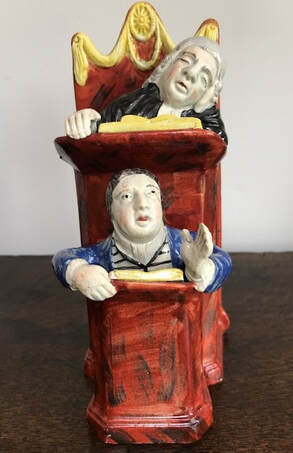
The Vicar and Moses
Myrna Schkolne in Volume 2 of her book “Staffordshire Figures 1780-1840”, has Chapter 109 entitled Religious Officials and Observers. She makes the point that the Church of England clergy in the late eighteenth and early nineteenth centuries were high living at that time and were ready targets for ridicule. They were high living as many […]

The Legend of Gelert the Dog
One of the best known and loved folk-tales in Wales is the story of a faithful hound, and the Staffordshire potters were as always, quick to capitalise on this sad and poignant tale. The story goes that in the thirteenth-century, Prince Llywelyn the Great had a palace at Beddgelert in Caernarvonshire, North Wales. The Prince […]

Watch stand
Clocks were expensive and therefore only found in the homes of the better off in the eighteenth and early nineteenth centuries. However, the master of the house generally had pocket watches and the Staffordshire potters were quick to latch onto a way of selling their wares by producing watch holders of all types. This is an early […]
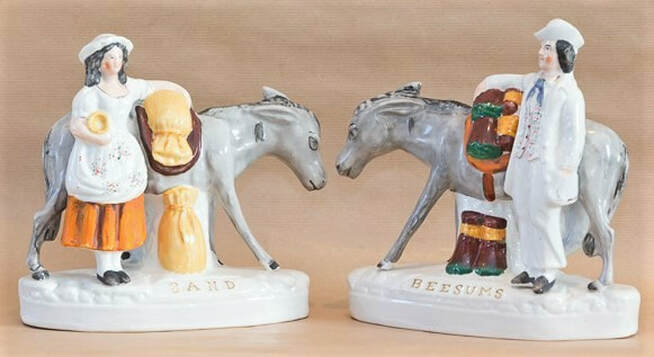
Sand and Beesums
The Victorian potter was good at making models of all kinds… royalty, politicians, criminals and animals, and also models depicting scenes of every day life. The figures entitled “Sand” and “Beesums” are just such models and show travelling salespeople who would probably go from town to town and village to village selling sand and beesums to the peasant […]
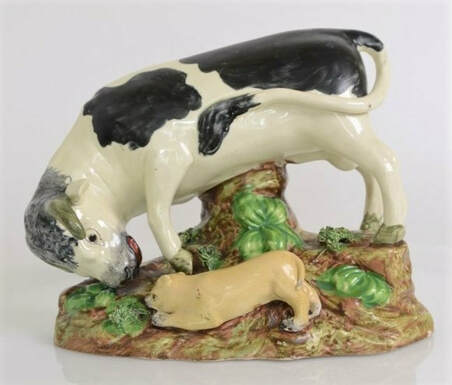
Bull-baiting figure
Bull-baiting was an ancient sport which involved pitting a bull against another animal. This was usually a dog such as a bull terrier, bull dog or mastiff. In England during the time of Queen Anne, bull-baiting was practiced in London at Hockley-in-the-Hole twice a week and was also reasonably common in provincial towns. At Tutbury, a […]

Hare coursing watch stand
At this time of year in the UK, if you are fortunate you can sometimes see male hares boxing each other in the fields. This particular figure depicts hare coursing which was until relatively recently a popular country pursuit. Usually two greyhounds were released to chase a hare to the death. The hare was not […]

Cymon and Iphigenia
These figures portray Cymon and his beloved, Iphigenia. In 1700, John Dryden published their story as a poem in his Fables, Ancient and Modern. The tale has ancient roots for Cymon is the hero of The Decameron, a novella by Giovanni Boccaccio written in around 1350. The narrative tells that Cymon’s aristocratic father considers him a dolt and […]
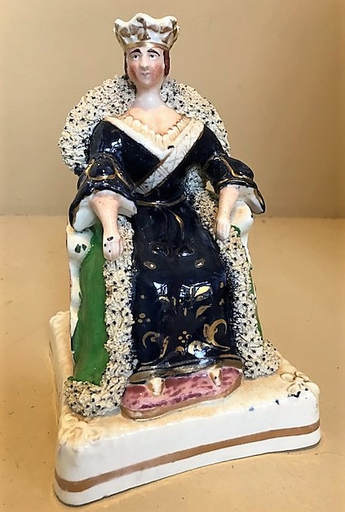
Queen Victoria
The year 2019 marks the 200th anniversary of the birth of Queen Victoria who was potted in many forms by the Staffordshire potters. It therefore seems entirely appropriate for us to start this year with a figure of the Queen as our Figure of the Month. Victoria (Alexandrina Victoria; 24 May 1819 – 22 January 1901) […]
Figures of the month 2018

Sherratt spill vase
This spill vase was made in Staffordshire circa 1820 by the “Sherratt” pot bank. “Sherratt” figures are known for their whimsical humor, and this vase is no exception. The rampant lion and unicorn stand as they do on Britain’s royal coat of arms, but “Sherratt” replaced the traditional shield between them with a clock, perhaps […]

Pair of coursing greyhounds
The greyhound or whippet was a popular dog to own in Victorian times and therefore a popular subject for the Staffordshire potter. They were principally a dog of the wealthier classes who used them to pursue the sport of coursing (using dogs to chase and catch hares or rabbits by speed and sight but not […]
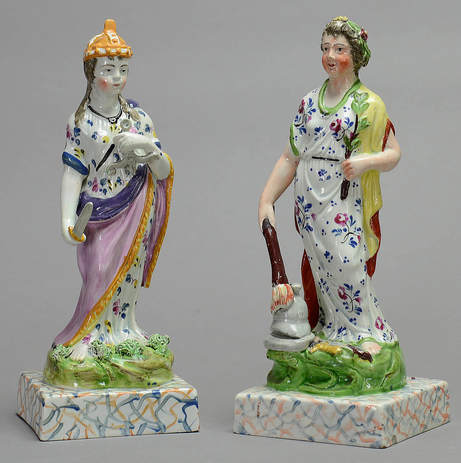
Peace and Justice
This fine pair of figures portraying Peace (right) and Justice (left) was made in Staffordshire in around 1810. Justice holds a sword signifying her power and a scale symbolic of fair measure. Peace is crowned with a laurel wreath. She holds an olive branch in one hand and with the flaming torch in her other […]
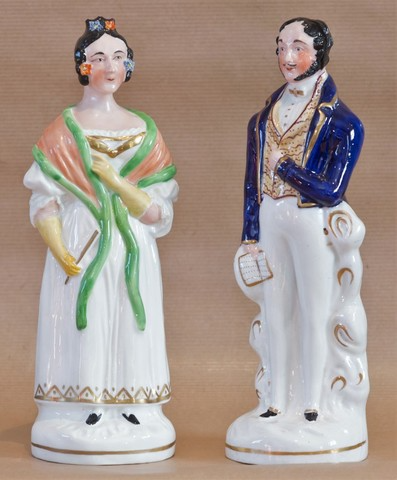
Victoria and Albert
Figures of Victoria and Albert were made in profusion and there are many models illustrated in the Harding directories. However, quality varies and this particular pair are both fine and rare. It is unusual to see a figure of Victoria without either a crown or hat of some description on her head. These figures were made in […]

Slavery Abolition figure
In 1834, the Slavery Abolition Act abolished slavery in Britain’s colonies. This figure of a kneeling slave may predate emancipation and perhaps was made to support the abolitionist cause. It is reminiscent of the Slave Emancipation Society medallion that William Hackwood designed circa 1787, bearing the words “Am I not a man and a brother?”
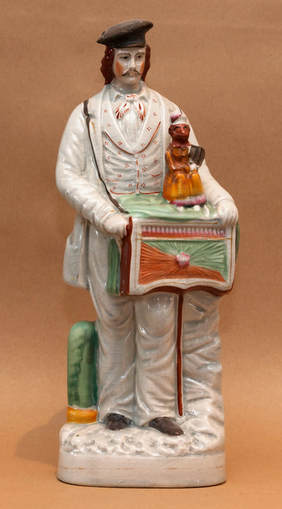
Organ grinder and monkey
Street vendors and street entertainers were commonplace on the streets and at country fairs in Victorian England. This figure is of such a person who would travel from place to place entertaining those he met with his barrel organ and his monkey. This is a big figure – perhaps 15 inches tall and circa 1870-80.
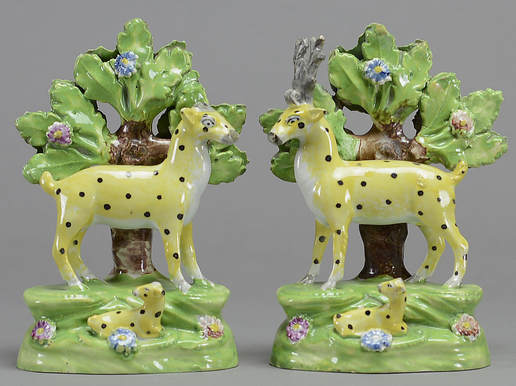
Sherratt pair of deer
This pair of deer, made in Staffordshire circa 1830, is attributed to the “Sherratt” pot bank. At the time they were made, deer hunting had fallen from favour. By then, deer, rather than being perceived as quarry, were appreciated as beautiful adornments for the estates of the affluent.

Freshwater fisherman
Another figure which simply depicts rural life in Victorian England. There are plenty of figures that represent sea fishermen and their wives but far less common are fresh water fisherman. This figure, circa 1860, shows a man on the banks of a fast flowing stream or river from which he has pulled a fine salmon […]

Sherratt Neptune and Venus
This pair of figures of Neptune and Venus was made by the “Sherratt” pot bank circa 1830. They are after earlier Derby porcelain figures, but the titled bases are typical of “Sherratt”. These figures must have been commercially successful in their time because “Sherratt” made them on assorted bases, and Venus can even be found […]

Pair of swans
This pair of swans would have adorned an ornamental pond in Victorian times. Many large Victorian houses had large heated glass conservatories or orangeries attached to them in which the house owner would grow exotic plants such as ornamental ferns and orchids. These buildings would also often contain a water feature such as a pond […]

King George IV
Prince George Augustus Frederick was born on 2 August 1762. He ruled Britain as Prince Regent from 1811 and on 29 January 1820, acceeded to the throne as King George IV. He is remembered for his flamboyant preferences that dictated the style later dubbed “Regency”, his succession of mistresses, and his troubled marriage that embarrassed […]

Soldier in a shoe figure
This is an interesting and unusual figure. It represents an unfortunate soldier or sailor who fought in the Crimean war and whose injuries resulted in him losing a leg or legs. It seems somewhat bizarre perhaps one might say cruel that he should find himself sitting in a shoe which is of course the very […]
Figures of the month 2017
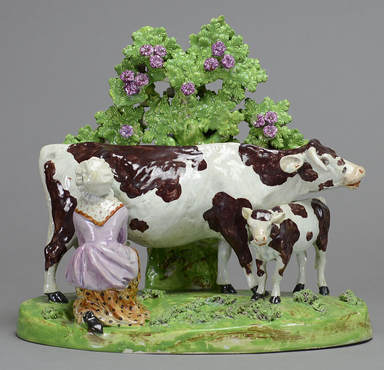
Milk maid at work
This apparently unique figure group, circa 1825, portrays a once-common sight in parks and on street corners across Britain. In the era before refrigeration, milk cows had to be located within quick reach of consumers. As the French-born American merchant Louis Simond tells in his journal in 1811, in London women bearing milk pails went door […]

Poachers
This rare figure depicts a confrontation between a poacher and a landowner. It is truly representative of rural life in Victorian times. There were many families living in the countryside but the size of their families coupled with low incomes meant they often resorted to poaching to find food to eat. Although this was commonplace […]

The Red Barn Murder
In 1828, William Corder went to the gallows for allegedly murdering Maria Marten and burying her body beneath the floor of his Red Barn. The Red Barn Murder was the crime of the nineteenth century, and earthenware portrayals are among the rarest of Staffordshire pottery objects.
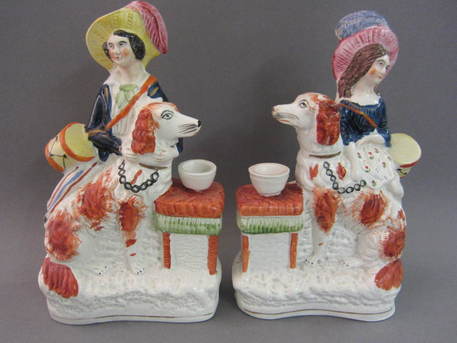
Pair of street musicians with dogs
A pair of Victorian Staffordshire figures, probably depicting street musicians with drums astride Irish setters. Is the bowl for feeding the dog or donations from the public?
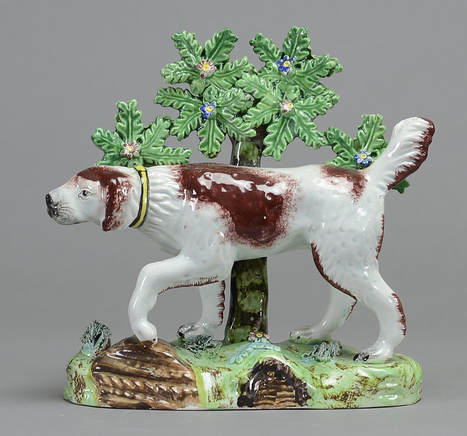
Hunting dog
From medieval times until 1831, game law restricted ownership of hunting dogs such as this pearlware pooch to landed gentry with sufficient income from land. This barred over 99% of the population from owning hunting breeds. The stars of the canine world then were pointers and setters. Their regal bearing made them gentlemen’s hunting helpmates, and those […]

Sir Robert Peel on horseback
Victorian Staffordshire equestrian figure of Sir Robert Peel, British Prime Minister in the 1830s and again in the 1840s. Peel was instrumental in the creation of the modern British police force, and the police nicknames “bobbies” and “peelers” are a tribute to him.

Chaucer and Newton
These fine figures of the poet Geoffrey Chaucer and the scientist Sir Isaac Newton, two men who shaped our world, were made in Staffordshire by Ralph Wood, circa 1785.

Britannia
A rare and large Victorian Staffordshire figure of Britannia seated above a clock face flanked by lions and holding the Union Jack aloft.

Urania watch holder
This pearlware watch holder, made in Staffordshire circa 1805, is almost 10 inches high. It depicts Urania, the Greek goddess of truth. Urania is also the muse of astronomy, and for this reason she is usually portrayed holding a globe or compass.

Zebra and fox spill vases
An unusual pairing of Victorian Staffordshire animal figures in the form of spill vases with leaping zebras and foxes.

Gentleman and dog
This splendid gentleman setting out for a day’s shooting has his dog at his side. The figure was made in Staffordshire circa 1820. In that time, only gentlemen with income from land of at least GBP100 a year were allowed to hunt game animals. Others who did so risked death or transportation.
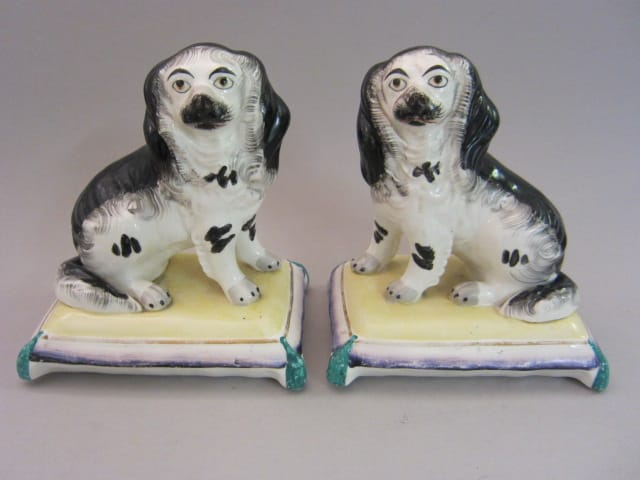
King Charles spaniels
What better way to start a new year than with man’s best friend: a pair of the ever-popular King Charles spaniels, seated contentedly on cushions.
Figures of the month 2016

Dandy group
All collectors love dandies, and the cute couple alongside are rather special in that, unlike all other dandies, they stand with a sheep, a goat, and two dogs. Made circa 1820 and only about 5 inches tall, this tiny treasure is the perfect eyeful.

Benjamin Franklin
The subject of US politics always makes for sensational news stories but how many of us have a figure of our favourite president or prime minister in our homes? This fine quality figure of Benjamin Franklin, one of the founding fathers of the United States, was made circa 1845.

Fancy musician spill vase
This stunning spill was made in the Staffordshire Potteries circa 1825 and can be attributed to the “Leather Leaf Group” pot bank. It is taller than most because the vase has been placed atop a plinth. Perhaps for this reason, the lady and gentleman musicians wear rather tall hats!
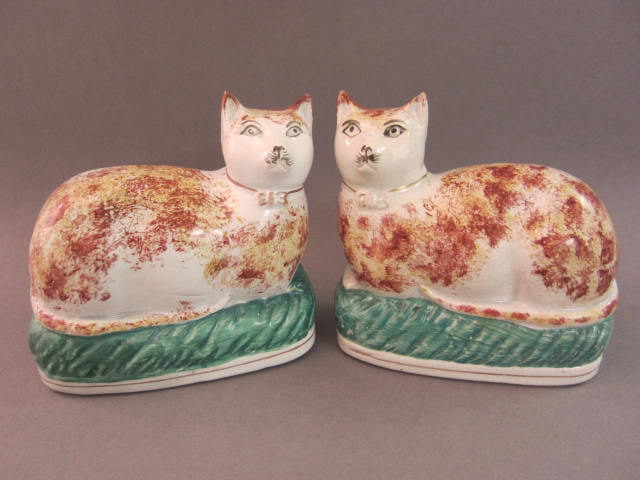
Pair of reclining cats
Relatively few fine cat figures were produced in the Staffordshire Potteries during the nineteenth century. This was because cats were not yet widely accepted as domestic animals and were still associated with witchcraft. This fine pair of recumbent cats date to circa 1850.

Jim Crow
This figure depicts the American actor Thomas Dartmouth Rice in the role of Jim Crow. Rice created the Jim Crow routine in the US circa 1828 and performed it on the London stage in 1836. His performance was a sell-out, and Jump Jim Crow quickly became an international song and dance sensation. This figure was made circa […]

Don Quixote
Many Victorian Staffordshire figures depict characters from literature, as does this fine figure of Don Quixote, from Miguel de Cervantes’s novel The Ingenious Gentleman Don Quixote of La Mancha. This example is decorated in the manner of the Thomas Parr Factory.
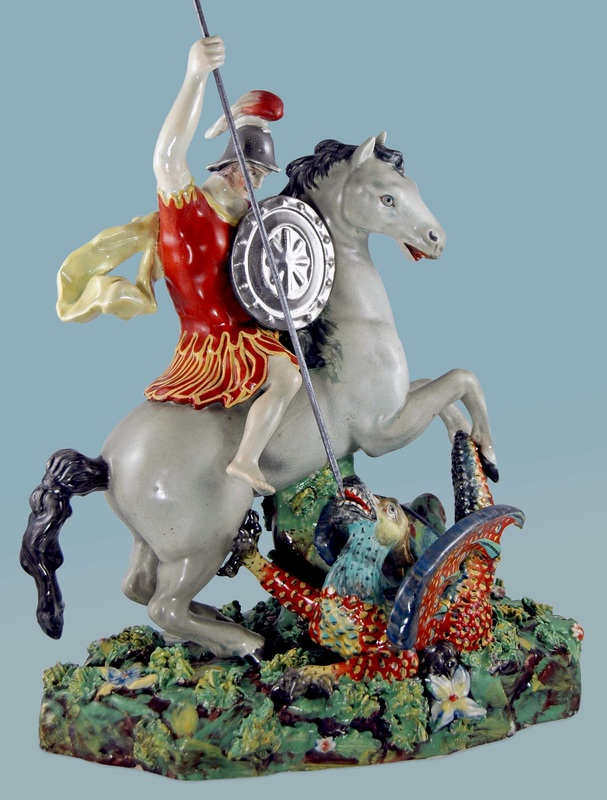
Saint George and the dragon
The pot bank of Enoch Wood and James Caldwell made this splendidly painted figure of Saint George and the dragon some time between 1805 (when silver lustre was introduced commercially) and 1818 (when the Wood & Caldwell partnership dissolved). Wood & Caldwell made this figure in two sizes, this being the larger.
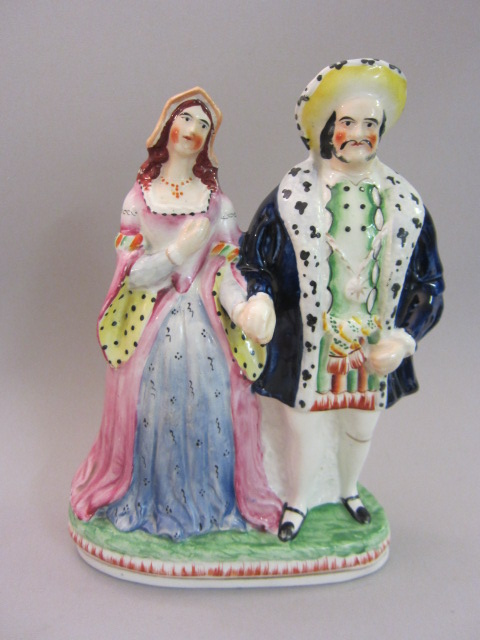
Henry VIII and Anne Boleyn
Victorian Staffordshire potters produced figures of contemporary royalty in great abundance. They potted many figures of Queen Victoria and Prince Albert and their large family, but they fashioned far fewer figures of royals of bygone times, such as this fine example of Henry VIII and Anne Boleyn.

Child chimney sweep
This petite pearlware figure of a chimney sweep alongside a woman, circa 1815, recalls the “climbing boys” (sometimes younger than six) who were forced to scale chimneys. This perilous occupation took its toll on the health and sometimes claimed the lives of these children.
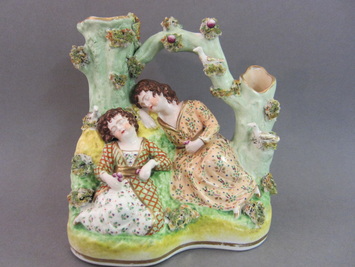
Babes in the wood
“Babes in the wood” is usually a relatively common and uninspiring Victorian figure, but this particularly early circa 1840 version is quite superior in both quality and decoration.

Piper and tambourine player
This piper and his companion tambourine player are among the earliest of enamel-painted figures. They were made by James Neale circa 1780, and she is impressed with the NEALE & CO. mark beneath.

Majesty and Grace spaniels
A classic pair of “man’s best friend” to start the new year. This pair of spaniels standing on pink bases decorated with leaves is known as “Majesty and Grace” and was made circa 1850.
Figures of the month 2015

Dr Syntax stopped by highwaymen
Titled on the plaque on the base DR SYNTAX STOPPED BY HIGHWAYMEN, this month’s figure is after a Thomas Rowlandson engraving by the same title. Rowlandson’s illustrations on the Dr. Syntax theme inspired William Combe’s amusing Dr. Syntax poems, published from 1809.
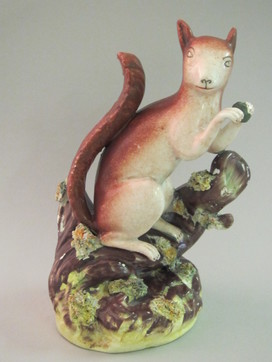
Squirrel with nut
This month’s figure is prompted by the furry devils that are in our gardens at this time of the year, burying nuts from our neighbours’ trees in everything from garden borders to small pots. Squirrels are quite rare in Staffordshire pottery, and this 9.5” tall version decorated in the manner of the Thomas Parr factory […]
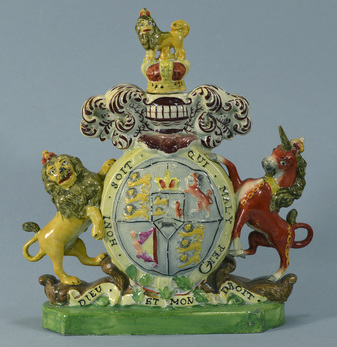
Lion and unicorn armorial container
A rare armorial container with removable stopper. The purpose of the container is unknown. It seems ill-suited for use as either a vessel for liquid or a spill vase, so perhaps it was intended to be purely decorative. Made circa 1820.
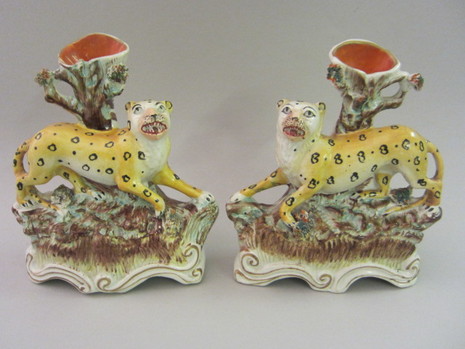
Pair of leopards
The Staffordshire potters of the early nineteenth century reflected the public interest in wild animals popularised by the travelling menageries. This fascination continued into the Victorian era. Leopards like this fine pair are rare and desirable. Made circa 1850.

Performing bear group
Most performing bear groups have a little lion (in reality, a dog dressed in a costume and wig) in the foreground, but now and again there is a monkey instead, as seen in this group.
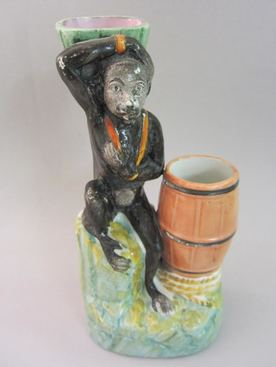
Monkey pluck figure
The figure was described in P.D. Gordon Pugh’s Staffordshire Portrait Figures book as “Monkey pluck.”

Bear baiting group
This stunning bear baiting group was formerly in the Hope McCormick Collection. The bear’s appealing expression and the man’s comic pose offset the savagery of the scene. The once-common sport of bear baiting was banned in England in 1835, so this rare group, made circa 1820, is a last reminder of a cruel sport that […]

Don’t you wish you may get it
A rare Victorian Staffordshire titled figure “Don’t you wish you may get it”depicting a dog tethered to a kennel, trying to get to a monkey on a barrel. Made circa 1860.

Tittensor group
Figures impressed “TITTENSOR” are so rare that this figure couldn’t resist sporting its rear view, complete with three marks. Unlike most bocage figures, which are enamel-painted, this group is decorated in under-glaze colours.
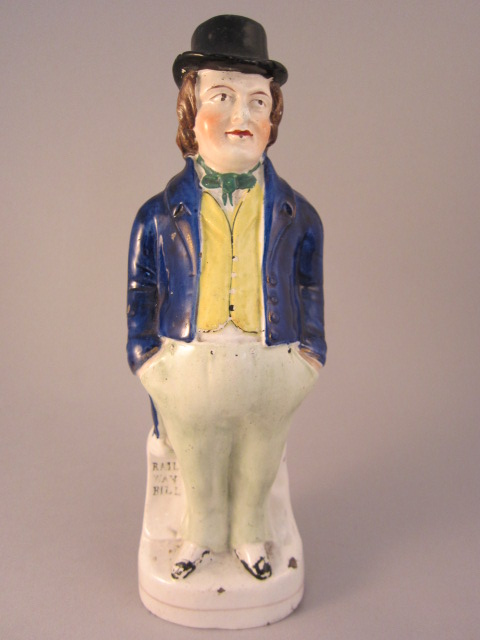
George Hudson
This very rare figure portrays George Hudson (1800-1871), who inherited a fortune and used it to invest in the early rail industry.
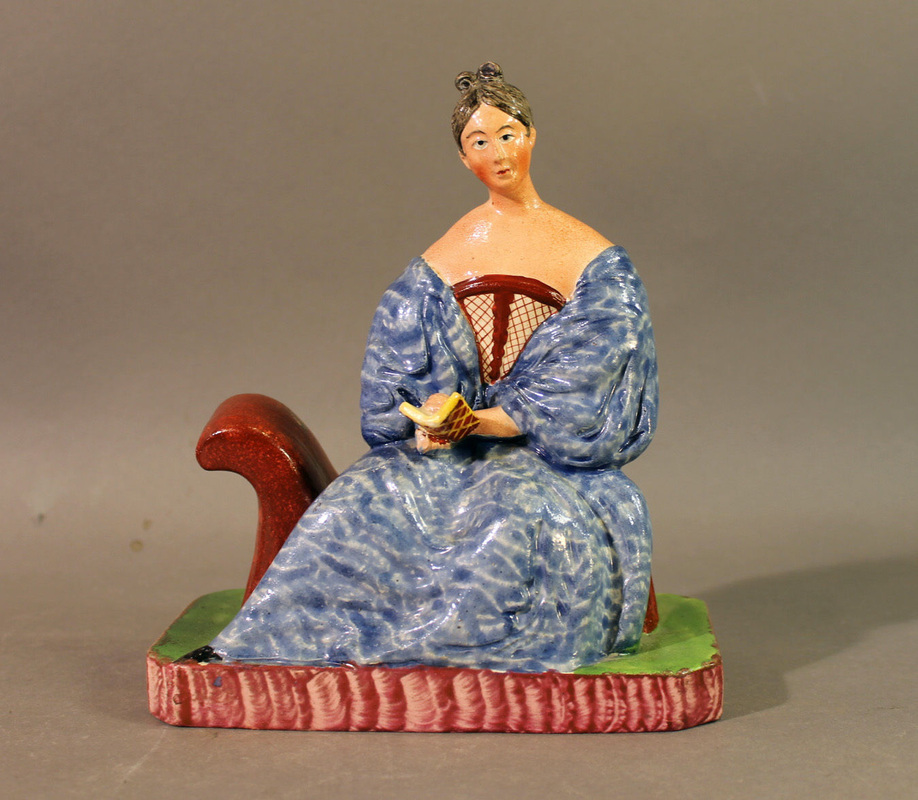
Maria Malibran
This particularly rare figure portrays Maria Malibran (1808–1836), a renowned beauty and an international mezzo-soprano of extraordinary vocal range and power.
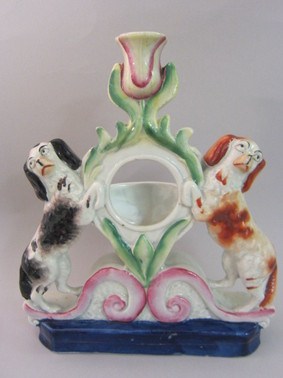
Spaniels watch holder
This rare and (so far) unrecorded Victorian Staffordshire figure, circa 1850, depicts spaniels on either side of a watch holder and is surmounted by a candle holder.
Membership
We warmly welcome new members – join us for free!
Wherever you are in the world, whether you are an experienced collector, a researcher interested in the folk art of England, or just someone who is intrigued by Staffordshire figures, please join us and get the rest of this year for free! Stay with us next year and pay an annual fee of £45 / $50 per household in January.


